Visibility was not good yesterday because wind kept roiling up the dust, and last night we were concerned that the blustery weather might prevent us from going out on the Sea of Galilee this morning. Although we saw an overcast sky when we pushed the curtains of our hotel room aside about 6:30 a.m., the wind had calmed considerably so the boat trip was on.
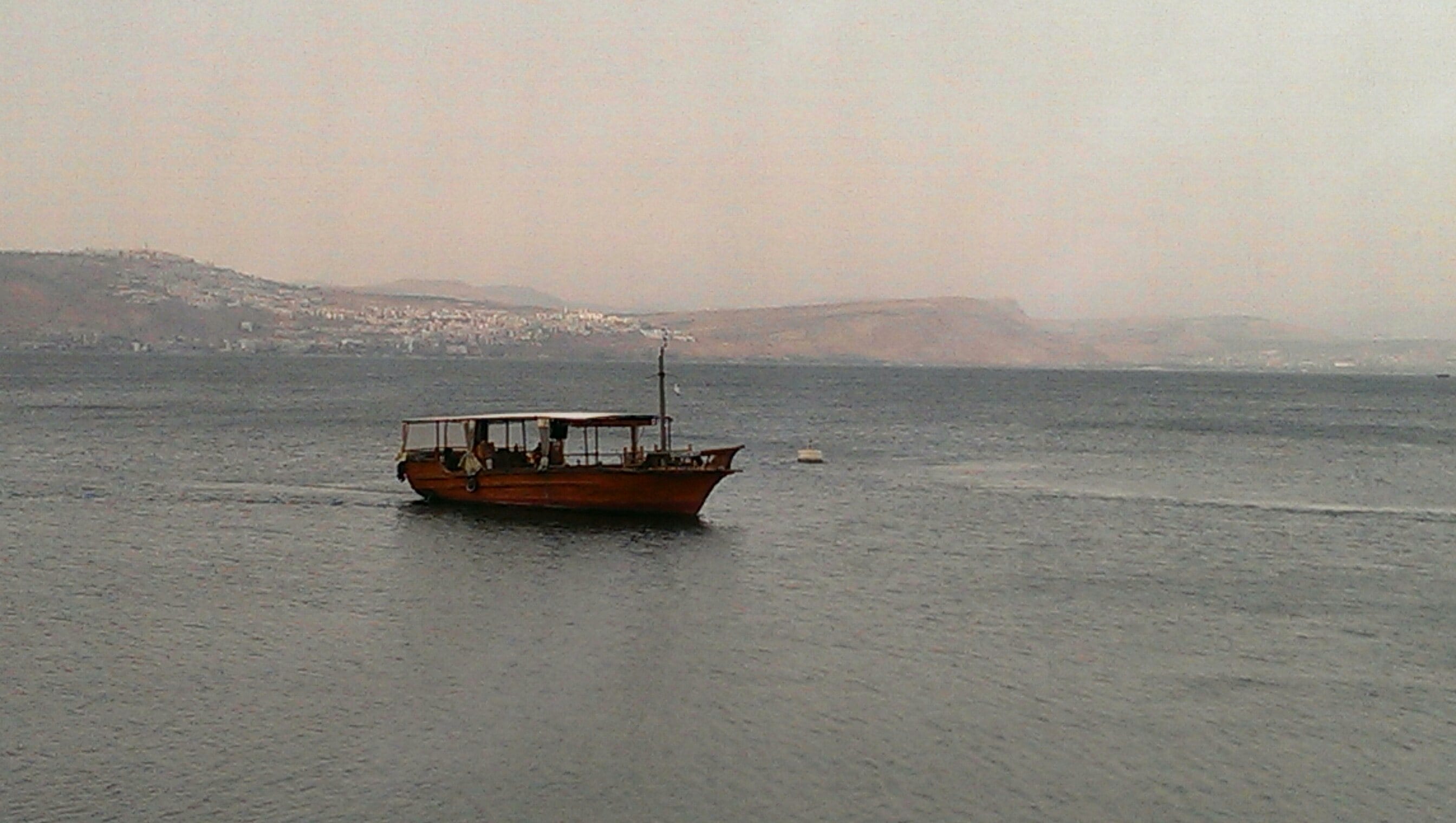
The Sea of Galilee
After breakfast, we drove from Tiberias on the western shore of the lake around to Ein Gev, a kibbutz on the eastern shore. The Sea of Galilee is nowhere near as big as the term “sea” implies; its longest dimension is less than fifteen miles, so circumnavigating the whole shoreline road doesn’t take much more than an hour. This morning’s route took us around the south shore, past some banana and date plantations operated by members of the kibbutz, and then to a small harbor where several fishing boats were moored.
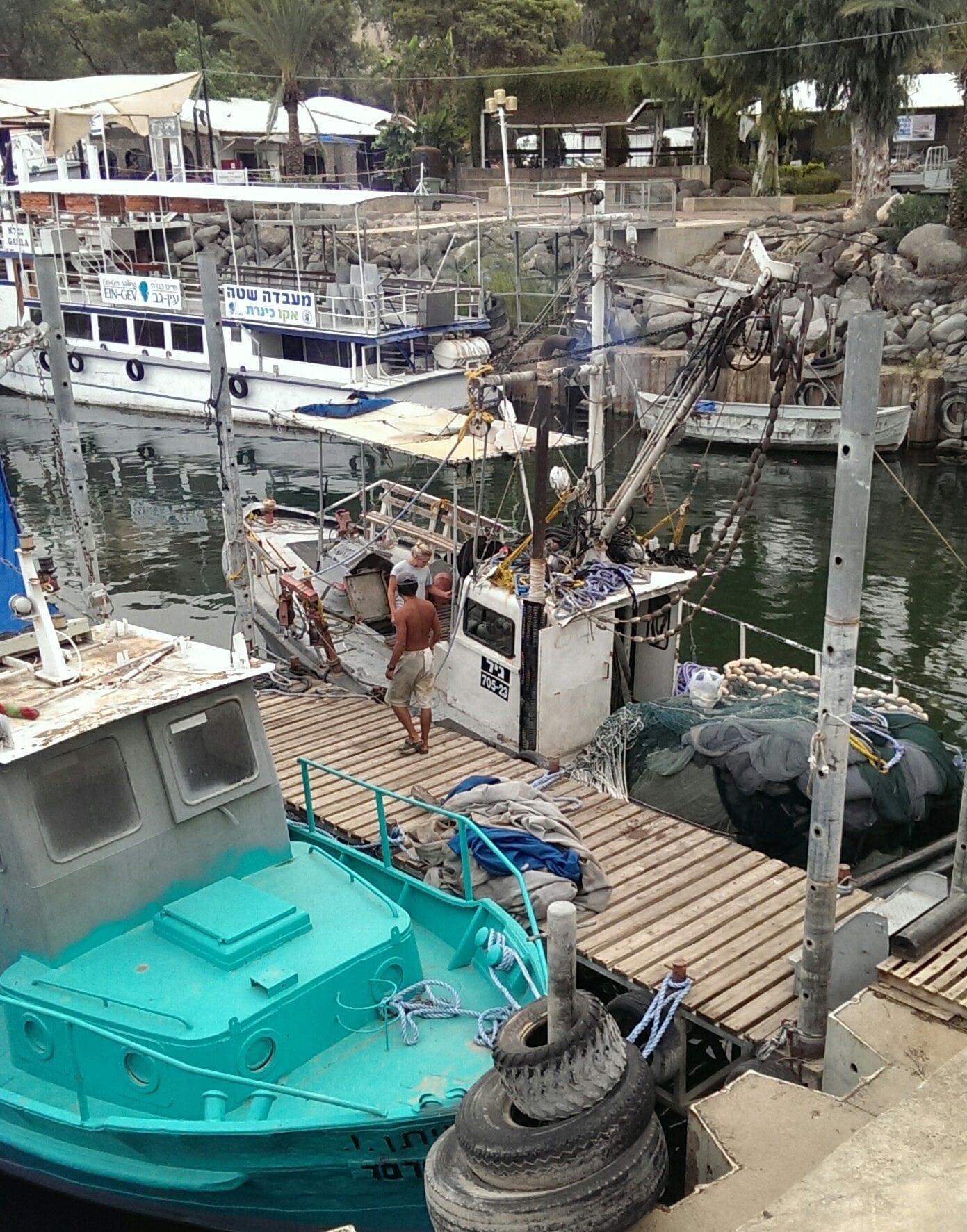
Fishing vessels still ply the Sea of Galilee
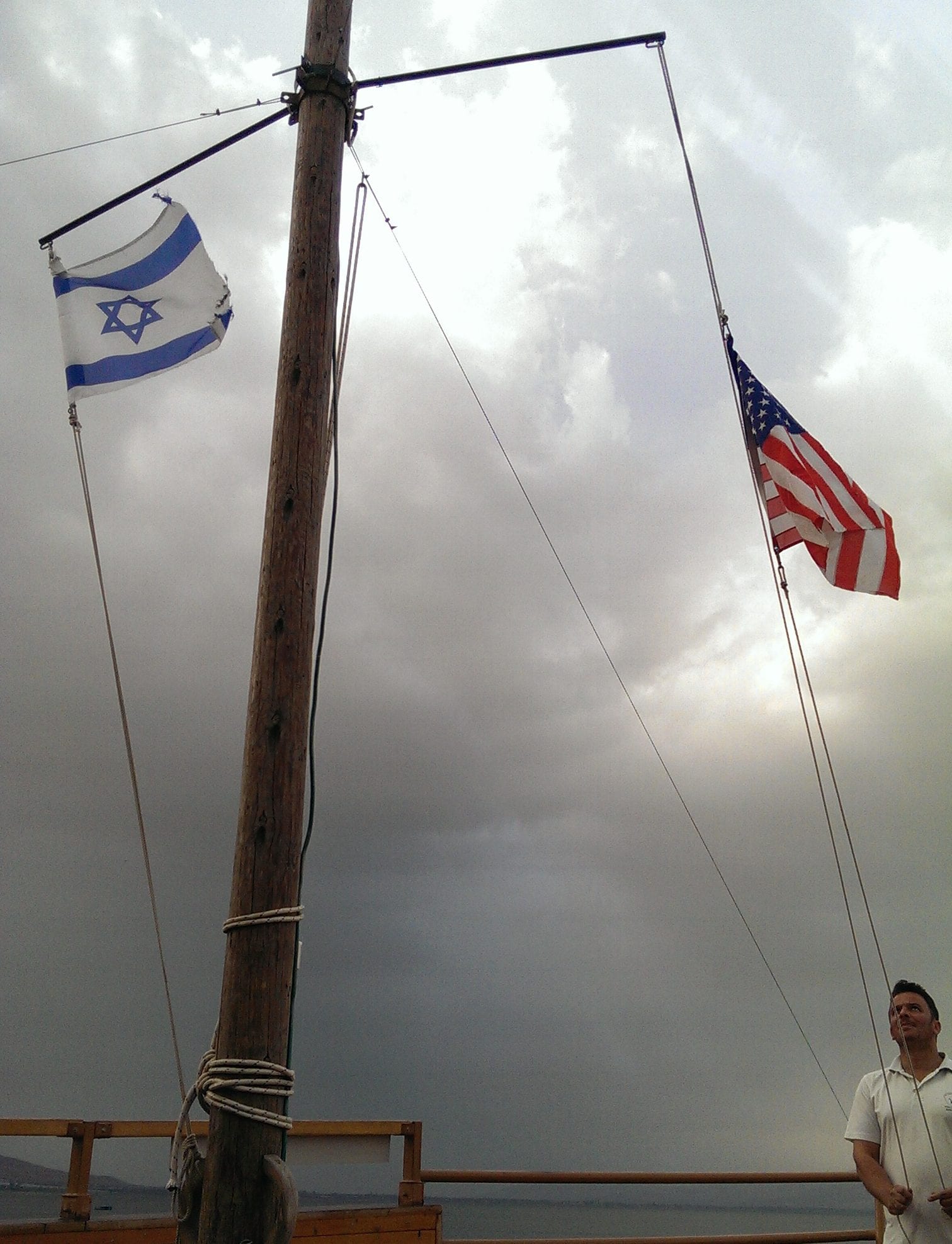
Raising the colors
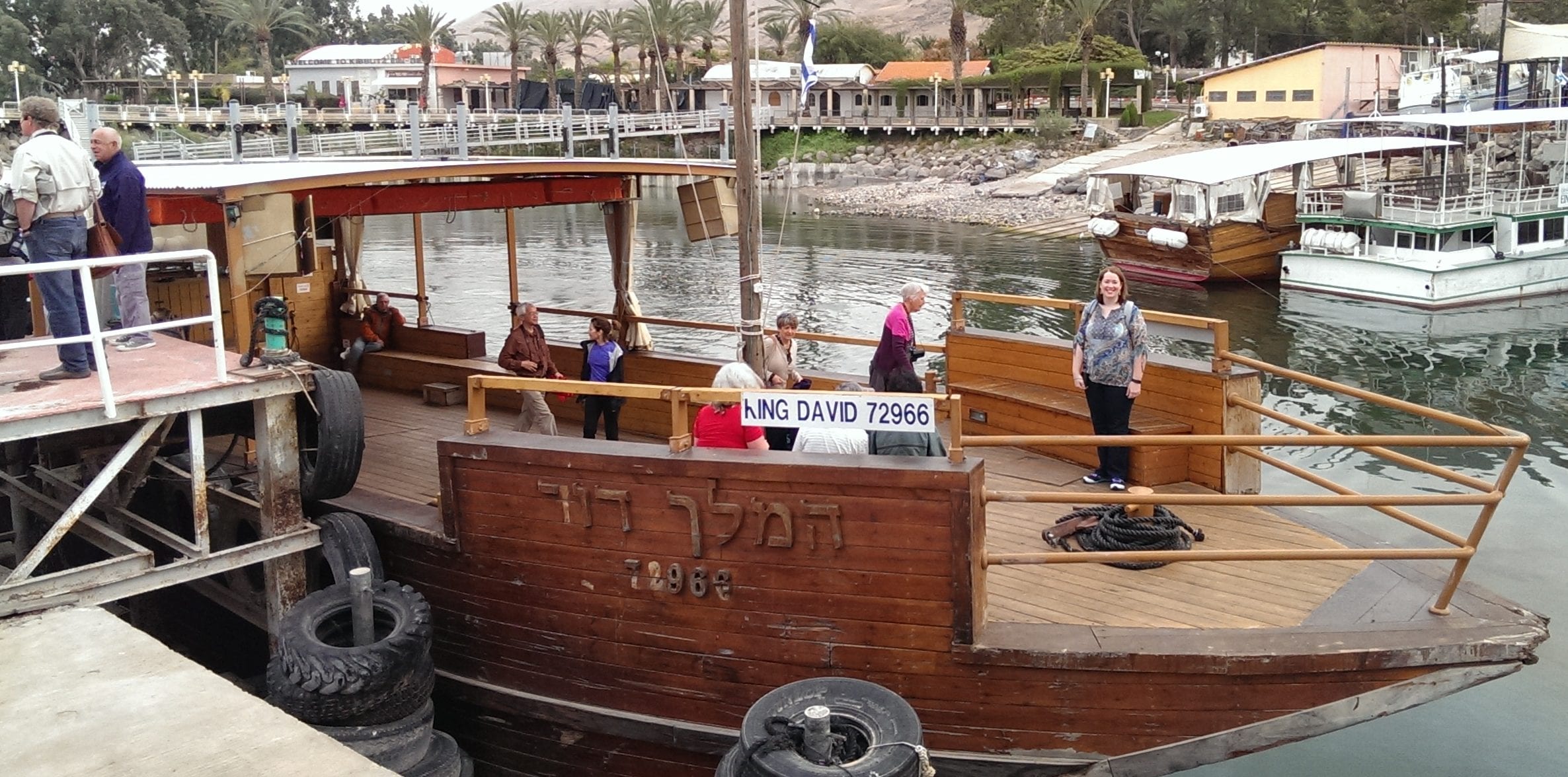
Boarding the King David for an early morning cruise
Having learned in Junior Sunday School about the terrible storm that frightened Jesus’s disciples as they crossed the Sea of Galilee, and having learned when we were older that such storms could arise very quickly on this lake, we knew that our pleasure cruise might not be so pleasant if the wind picked up again. However, this morning there were no tossing billows and no raging tempest during our 45-minute ride, though the wind was rather strong. Nevertheless, the water had a calming influence on us and the atmosphere was so peaceful that most of us wished we could have just spent the entire day out on the water.
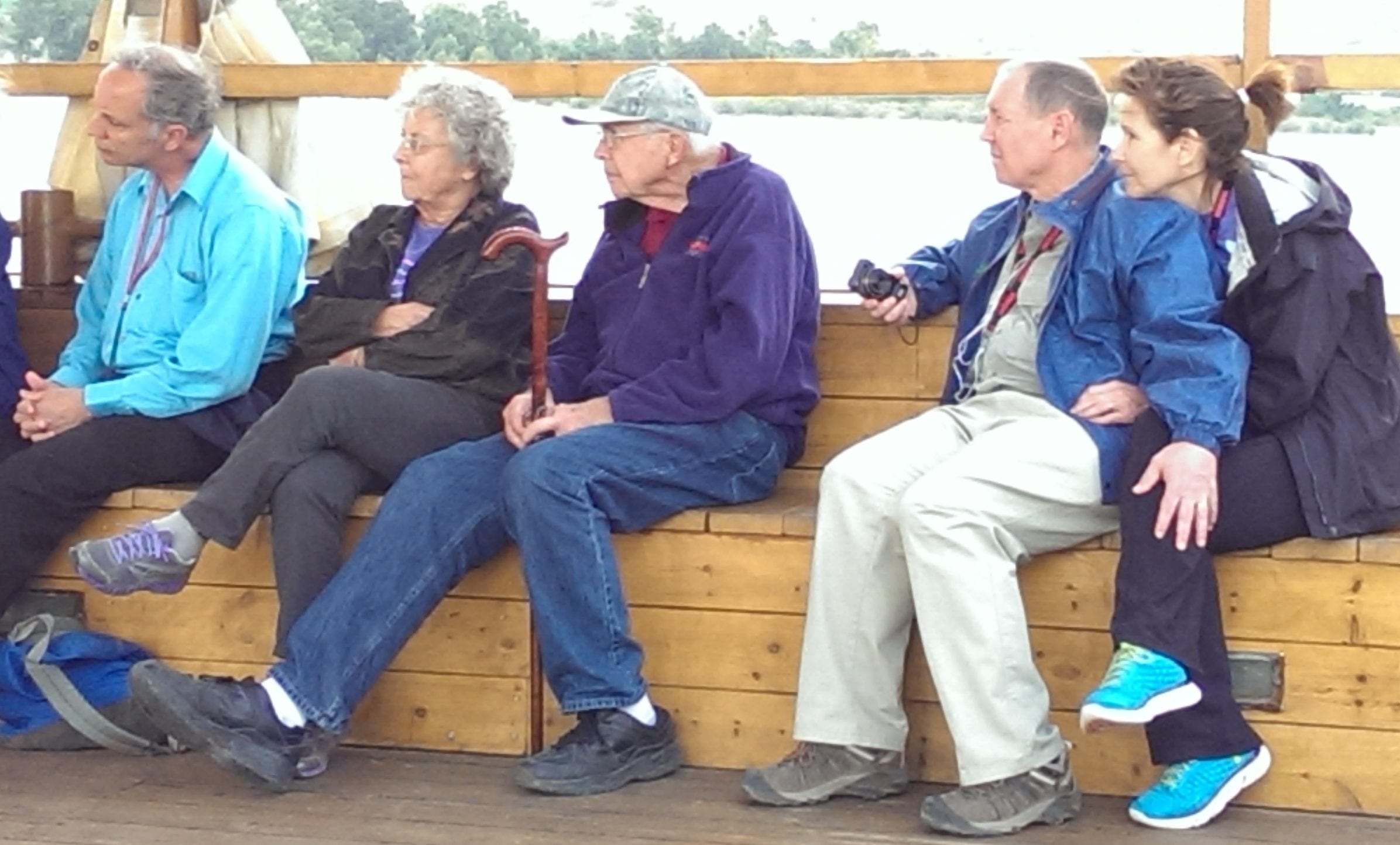
Mark, Marilyn, Al, Richard, and Judith listen intently to the devotional
The King David is a creaky craft built of wood, a replica of the type of boat Peter, Andrew, James, and John had cast their nets from–except that the King David gets auxiliary power from a diesel engine. Once we were settled on board, the crew hoisted an American flag alongside Israel’s blue and white Star of David and played a recording of “The Star-Spangled Banner.” Of course, we passengers had to sing along. After some safety announcements (which did not include anything about wearing life jackets), the captain cut the engine and let us us drift serenely over the surface of the water. Then Samir began the first of the day’s devotionals.
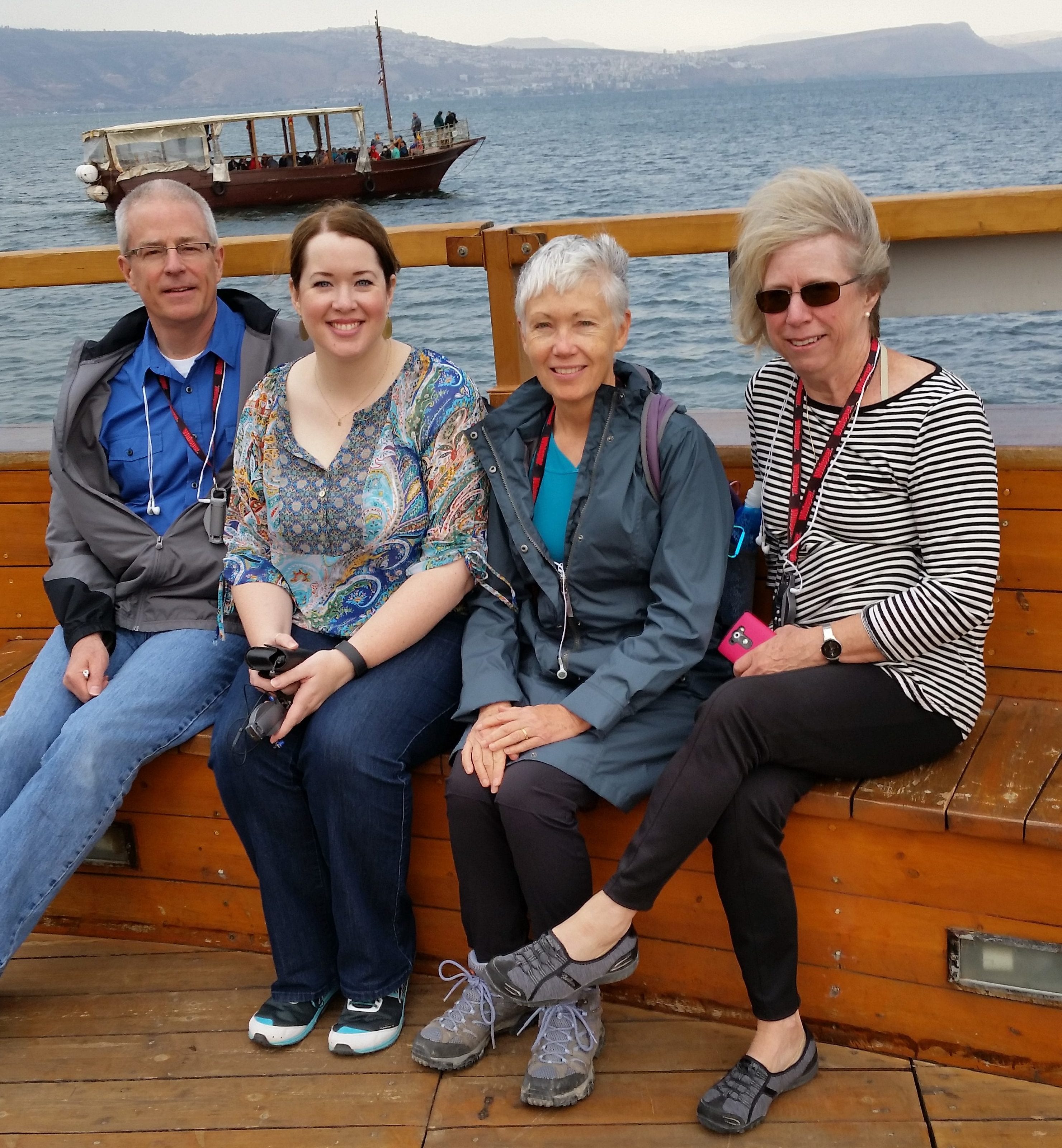
Family photo with Nancy’s niece Emery and Michael’s sister Pat
“The Sea of Galilee is fed by the Jordan River,” he said. “The water flows in one end and out the other. It stays fresh because it keeps moving, bringing life to the fish, to the plants, to the people who live around it. It is ‘living water’ because it gives as much as it takes.
“The Dead Sea also is fed by the Jordan River,” Samir went on, “but it is selfish. Everything it gets, it keeps. The water has become so stagnant that nothing can live in it or even around it. So this is the lesson: Being willing to give as much as you take brings life. Being selfish kills.”
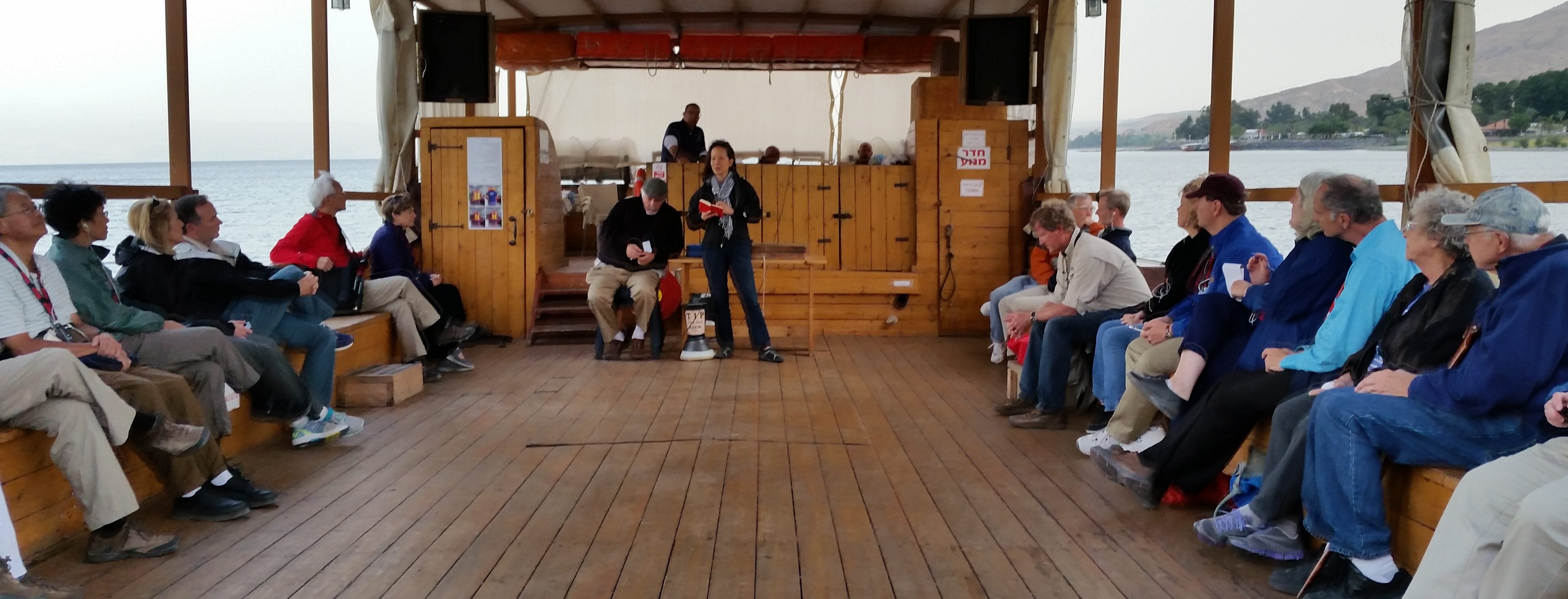
Marguerite sharing her gratitude
Next it was Marguerite’s turn to inspire. She told us how grateful she was to be on this trip, and especially to be able to fully participate in every adventure. Just eight years ago, she explained, she had been struggling with breast cancer and was convinced that she was going to die.
“One day, after months of chemo and radiation treatments, I felt my world literally getting smaller and smaller,” she said. “The light around me was growing dimmer. The sounds were growing fainter. I could not breathe. I was filled with despair. I wasn’t ready to die, so I called out, ‘Lord, save me!’ And just as he reached out to save Peter in his moment of despair, the Lord extended his arm to me.”
Marguerite bore mighty testimony of Christ’s power to save us through his love, no matter what our trials may be. Scott reinforced her message with his rich baritone, singing:
Jesus, lover of my soul,
Let me to thy bosom fly,
While the nearer waters roll,
While the tempest still is high.
Hide me, O my Savior, hide,
Till the storm of life is past.
Safe into the haven guide;
Oh, receive my soul at last.
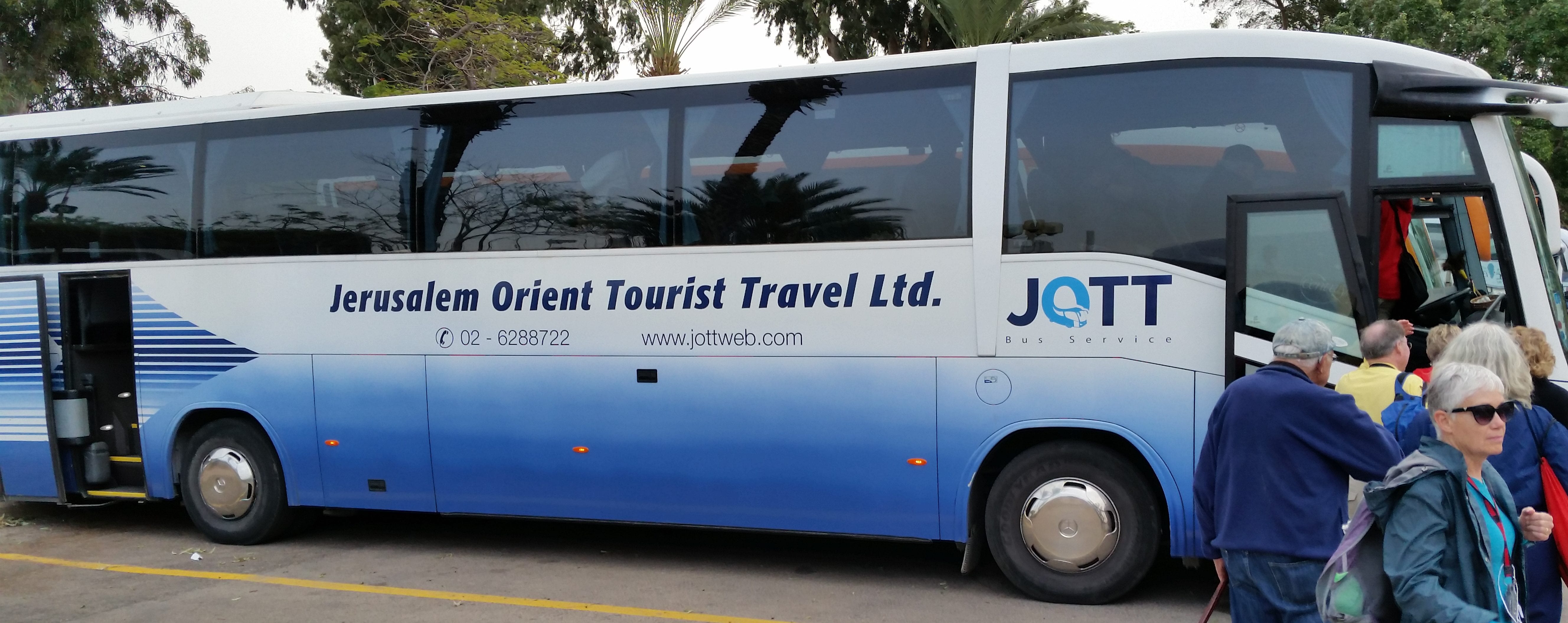
Our bus throughout Israel
Reluctantly leaving the peaceful water, we got back on the bus and continued up the east side of the lake. We passed through the Golan Heights, scene of much political and territorial contention in decades past, but today we felt none of that.
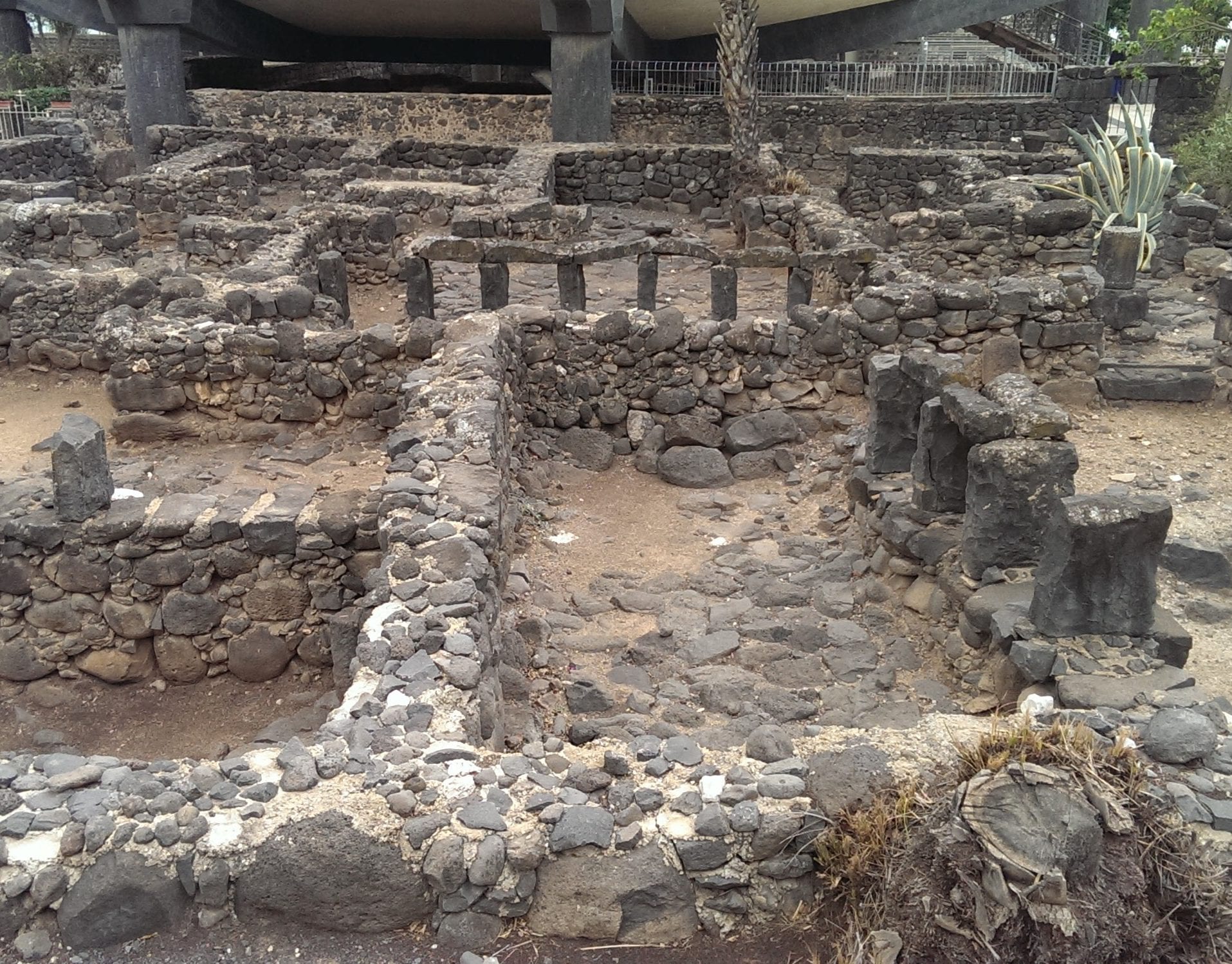
Roman-era ruins in Capernaum
Our next stop was Capernaum, home of Peter and Andrew. Jesus and his family moved here, too, when the people of Nazareth rejected him as a prophet and would no longer listen to his teachings. In contrast, the residents of Capernaum flocked to him, recognizing him not only as a great healer, but also as one who taught with authority.
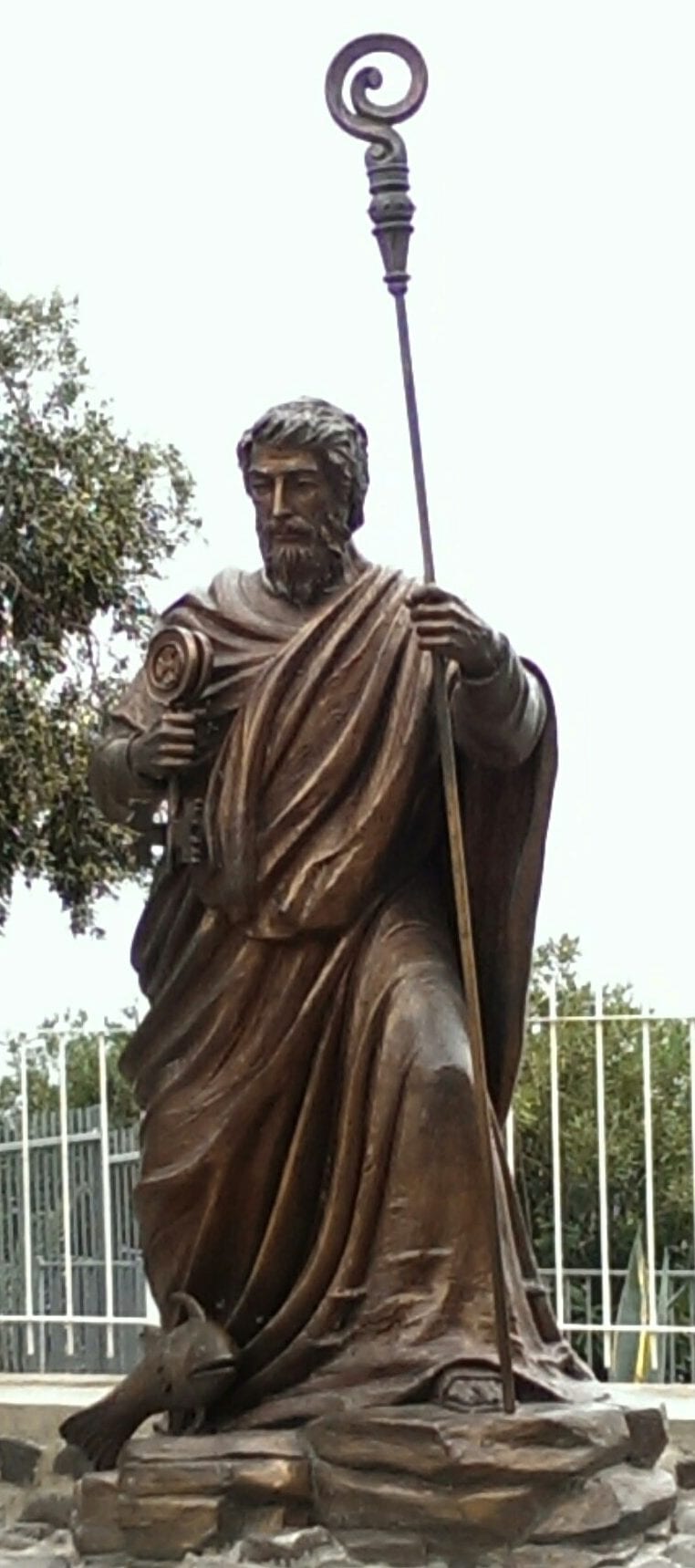
St. Peter presides over his hometown with the keys of the kingdom in hand
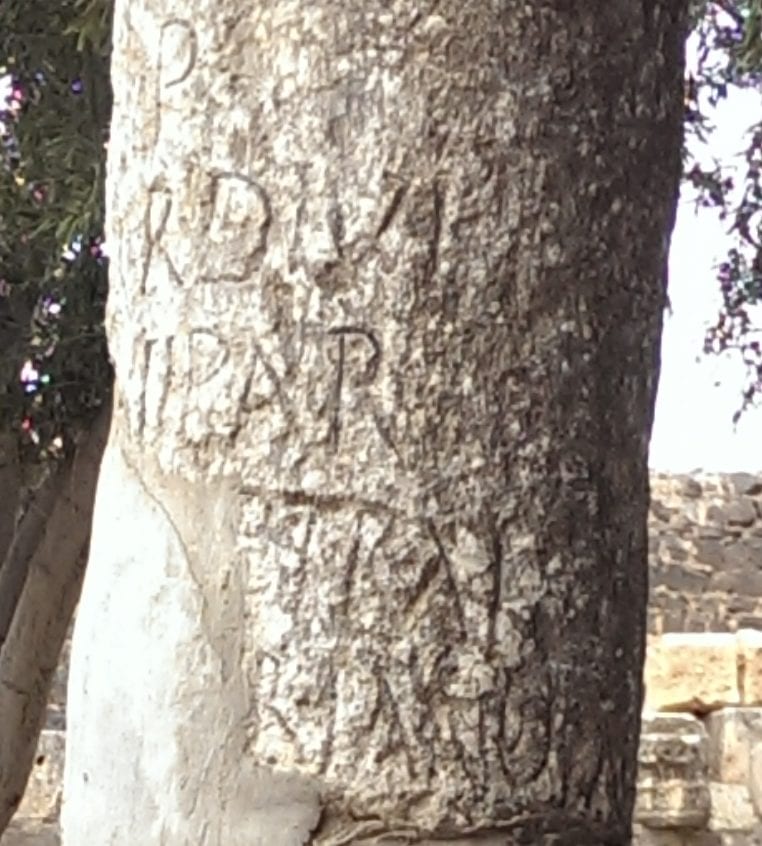
The Latin is still legible on this Roman milestone
The town that Jesus knew is now in ruins, but a Roman-era synagogue built on top of the earlier one where he came regularly to expound the scriptures has been partially rebuilt. This is where Christ performed many of the miracles reported in the New Testament.
One of the first of these was healing a Roman centurion’s servant. Though he belonged to the resented ruling class, the centurion was a good man: he had donated funds to build the older synagogue, and when he approached Jesus with his request, he demonstrated such humility and faith that the Lord publicly commended him.
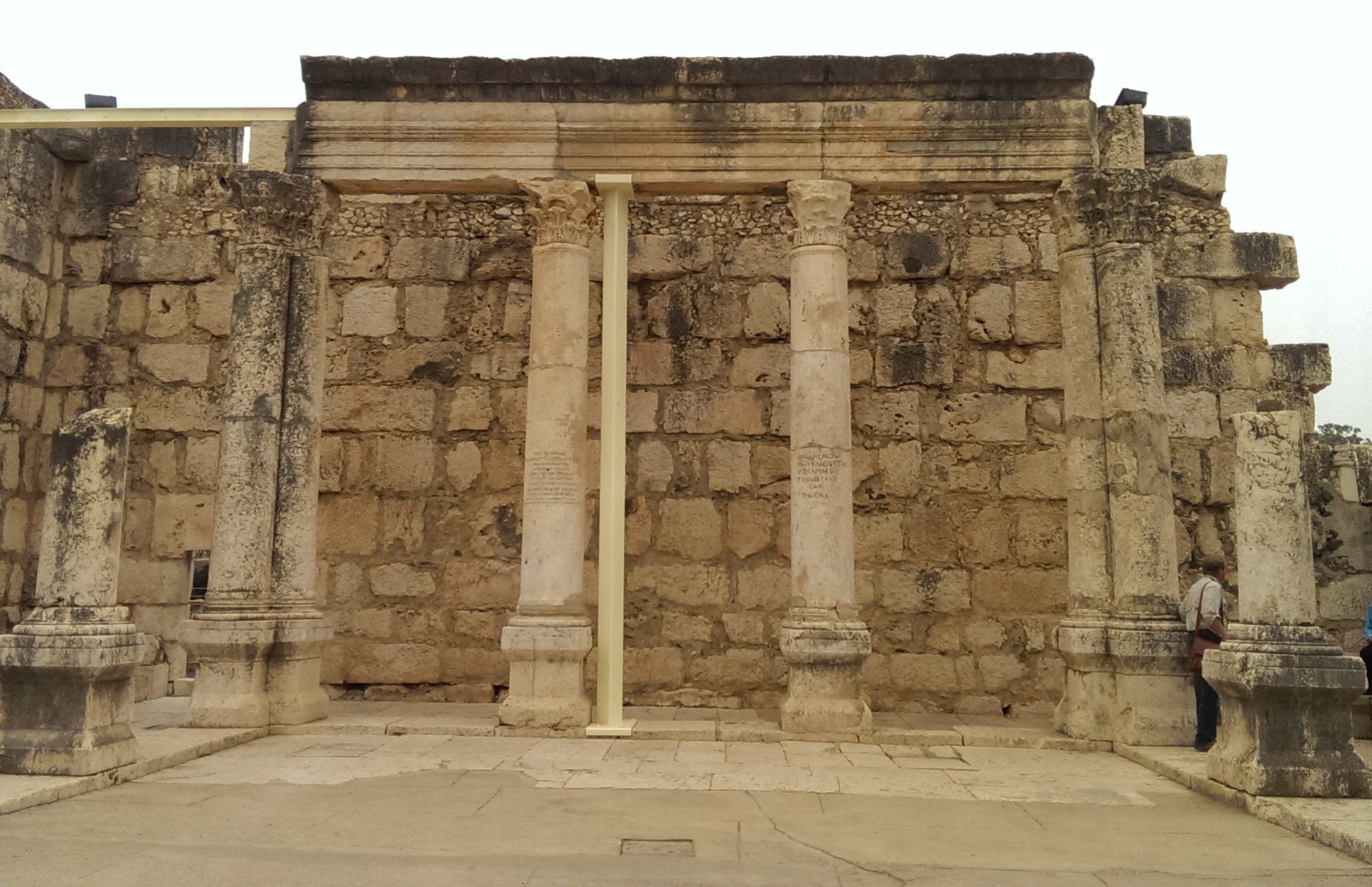
The synagogue at Capernaum
Another miracle performed on this site occurred when the synagogue was so crowded with people who had come to hear Jesus preach that a palsied man hoping to be healed could not even get near the door. The four men who had carried the sick man on his bed broke a hole in the roof and lowered him down to the Savior, who both healed his infirmity and forgave his sins.
One of Christ’s most important sermons was given in the synagogue at Capernaum, shortly after he miraculously fed more than five thousand people with five loaves of bread and two fish. Hundreds sought him out, hoping to see another miracle; but rather than supply them with free food again, Jesus advised them to seek the Bread of Life: the spiritual nourishment that only he could offer.
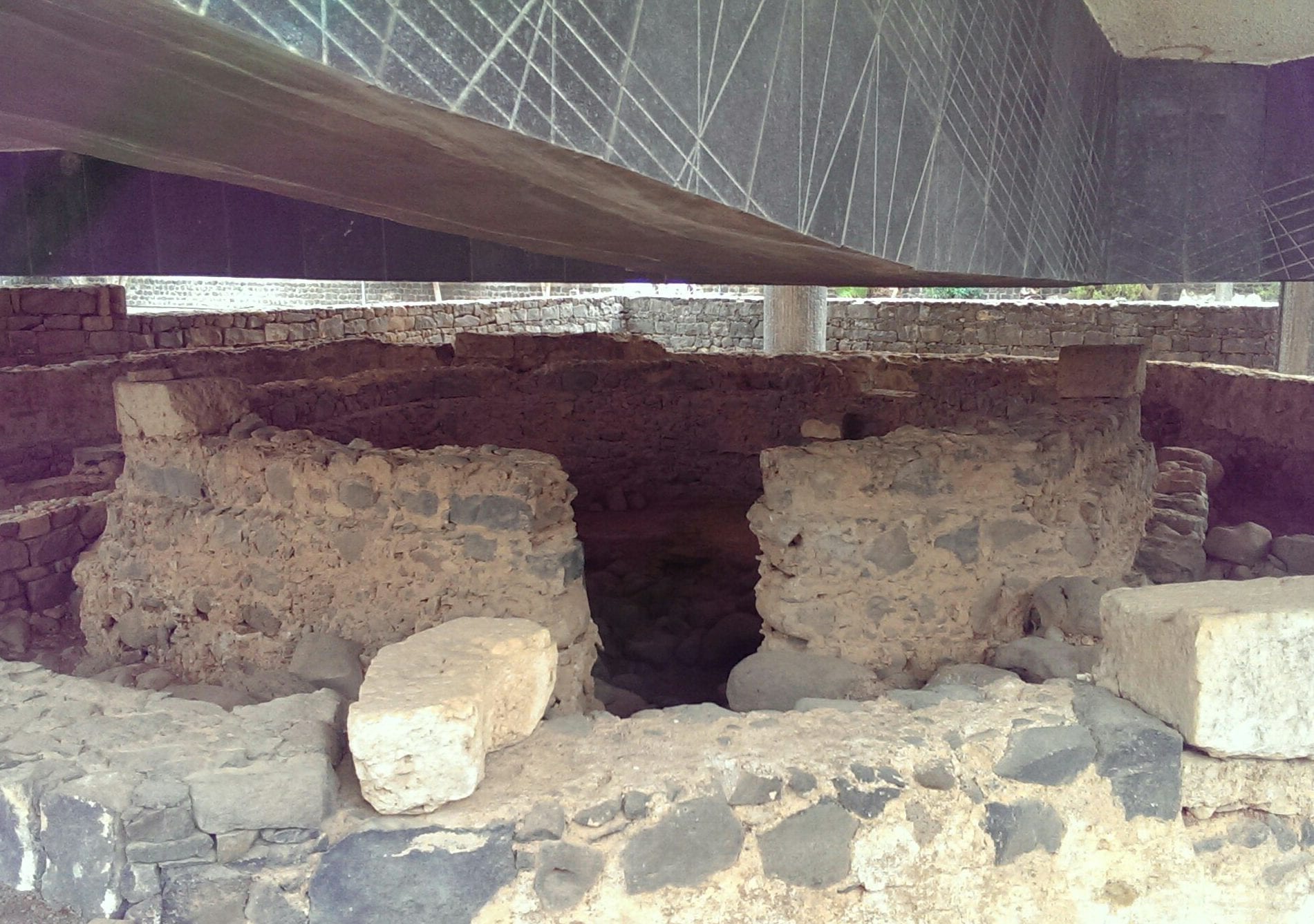
A modern pavilion protects the remains of a fifth-century church built on the site of Peter’s home in Capernaum
Other ruins in Capernaum include those of an early Christian church built on what is almost certainly the actual site of Peter’s home. When Peter brought Jesus here for the first time, they found his mother-in-law sick with a fever; Jesus immediately healed her.

Church of the Beatitudes
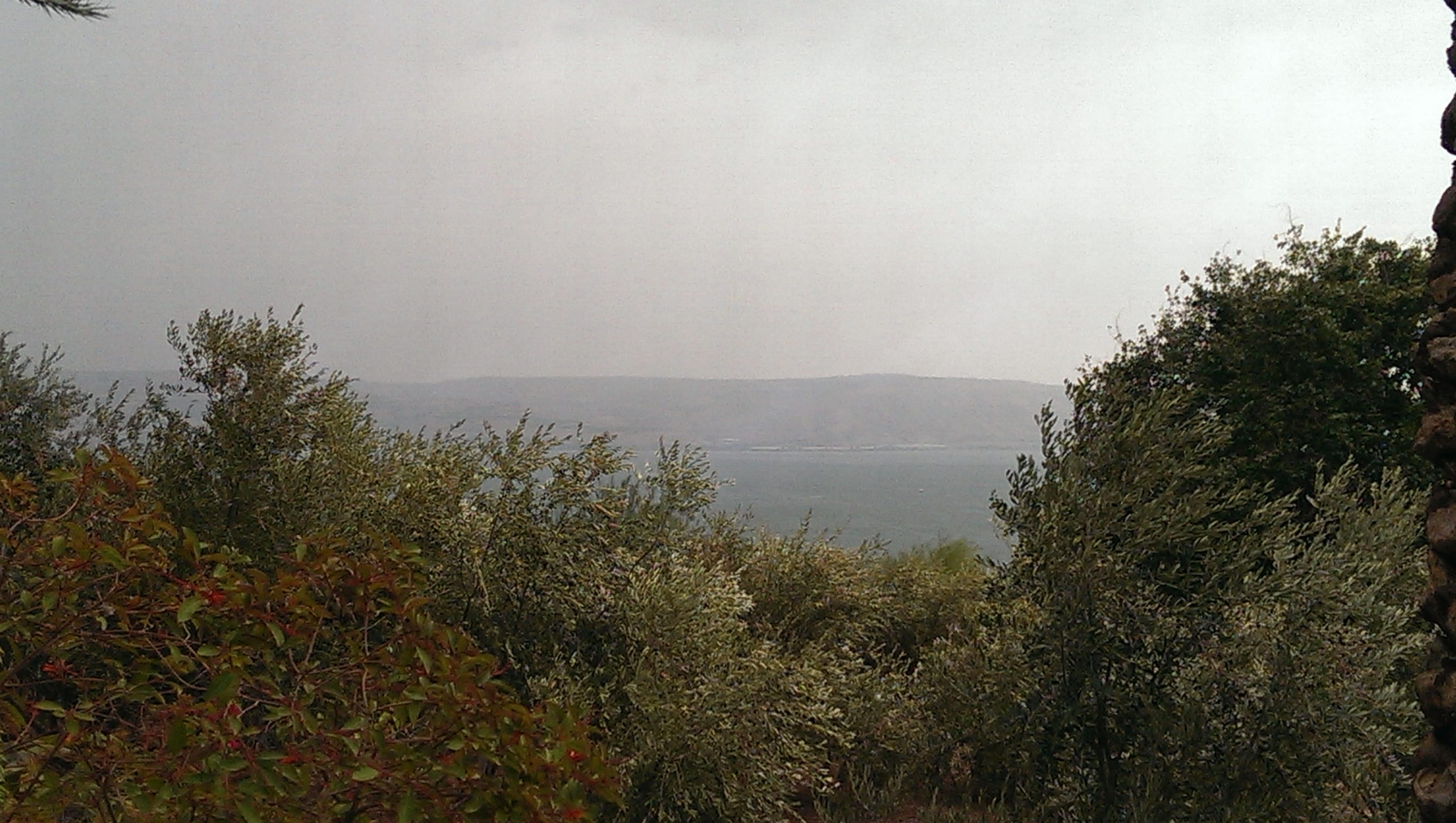
The view from the Mount of Beatitudes
Continuing west around the Sea of Galilee, we traveled to the Mount of Beatitudes. For at least 1600 years, tradition has recognized this place as the area where Jesus delivered the Sermon on the Mount. While the setting is not as bucolic as it probably was in New Testament times, when we looked past the commemorative monuments and out over the lake, we could get a sense of what Jesus’s followers might have experienced as they listened to him preach. Here, Nancy and Michael had the opportunity to present a devotional reviewing the highlights of Christ’s sermon, acknowledging that while each of us begins our journey through life from a different point, we come closer together when we are focused on coming to Christ.
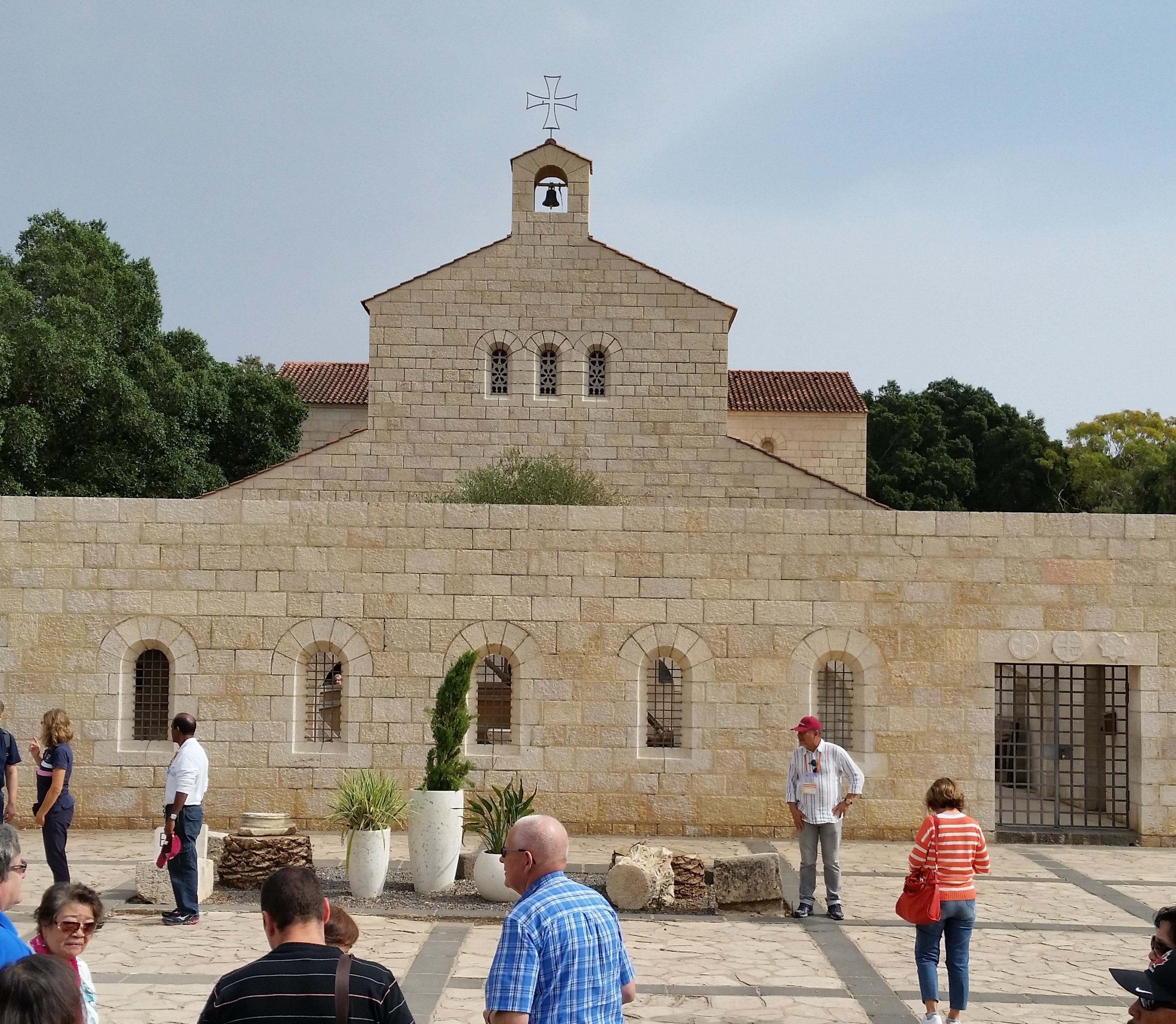
Church of the Multiplication
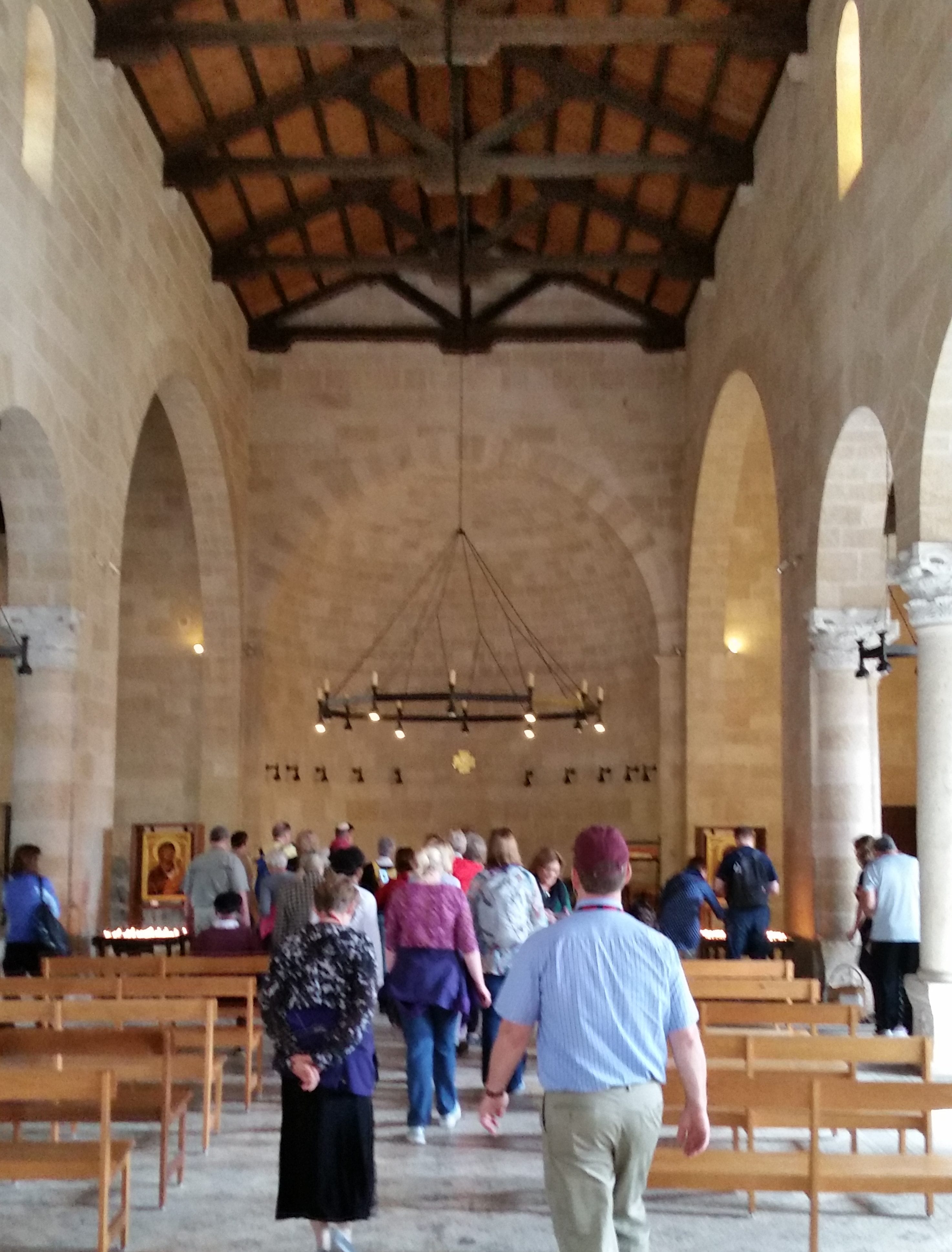
Nave of the Church of the Multiplication
Closer to the lakeshore is the Church of the Multiplication, commemorating the multiplication of the loaves and fishes that fed the five thousand. It’s not likely that the miracle actually took place here, because John recorded that the multitude had followed Jesus up a mountain; nevertheless, the church is a lovely place. Sadly, vandals had set fire to it earlier this year, but miraculously some beautiful mosaics survived.
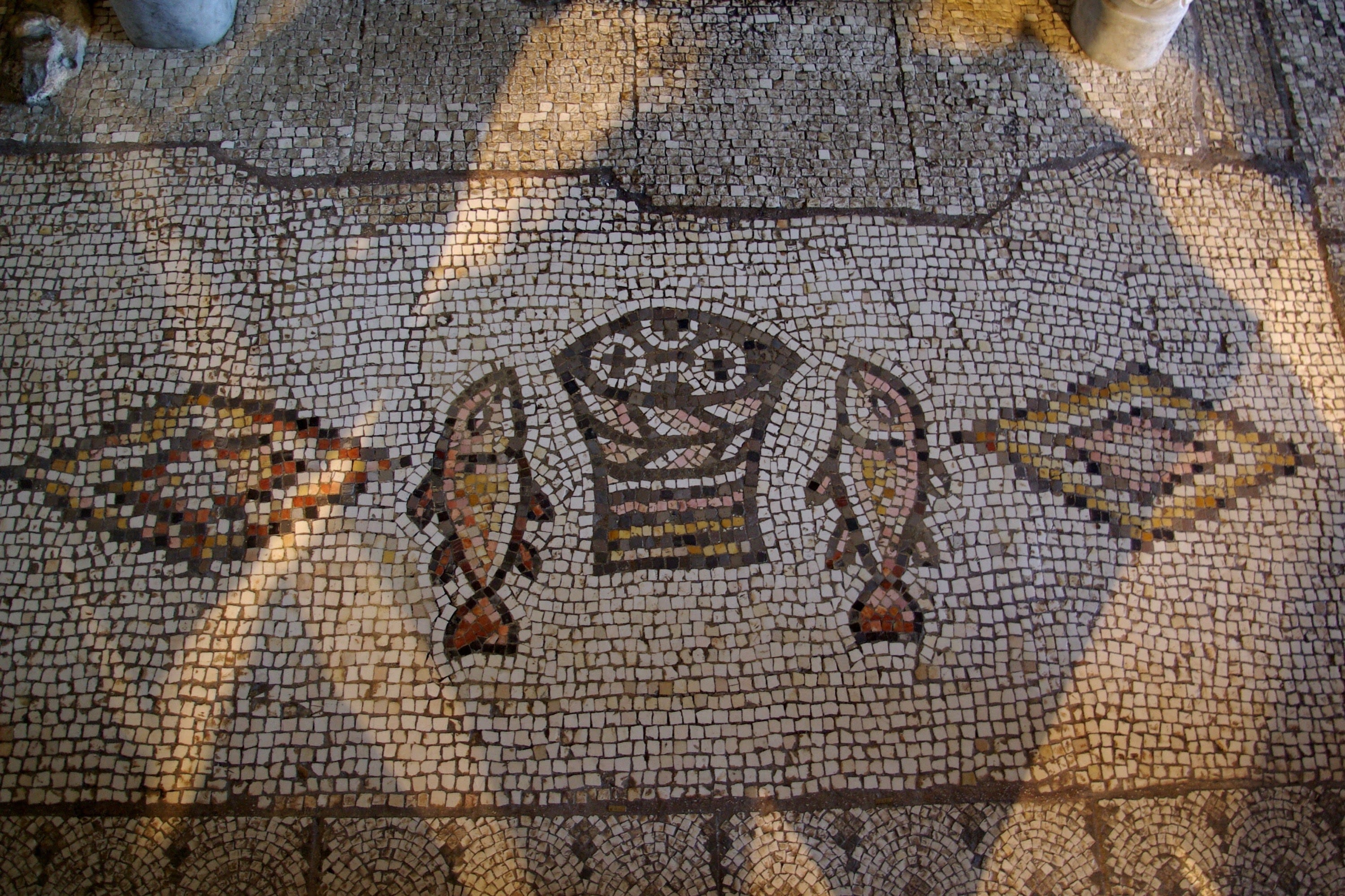
Mosaic commemorating the loaves and fishes in the Church of the Multiplication
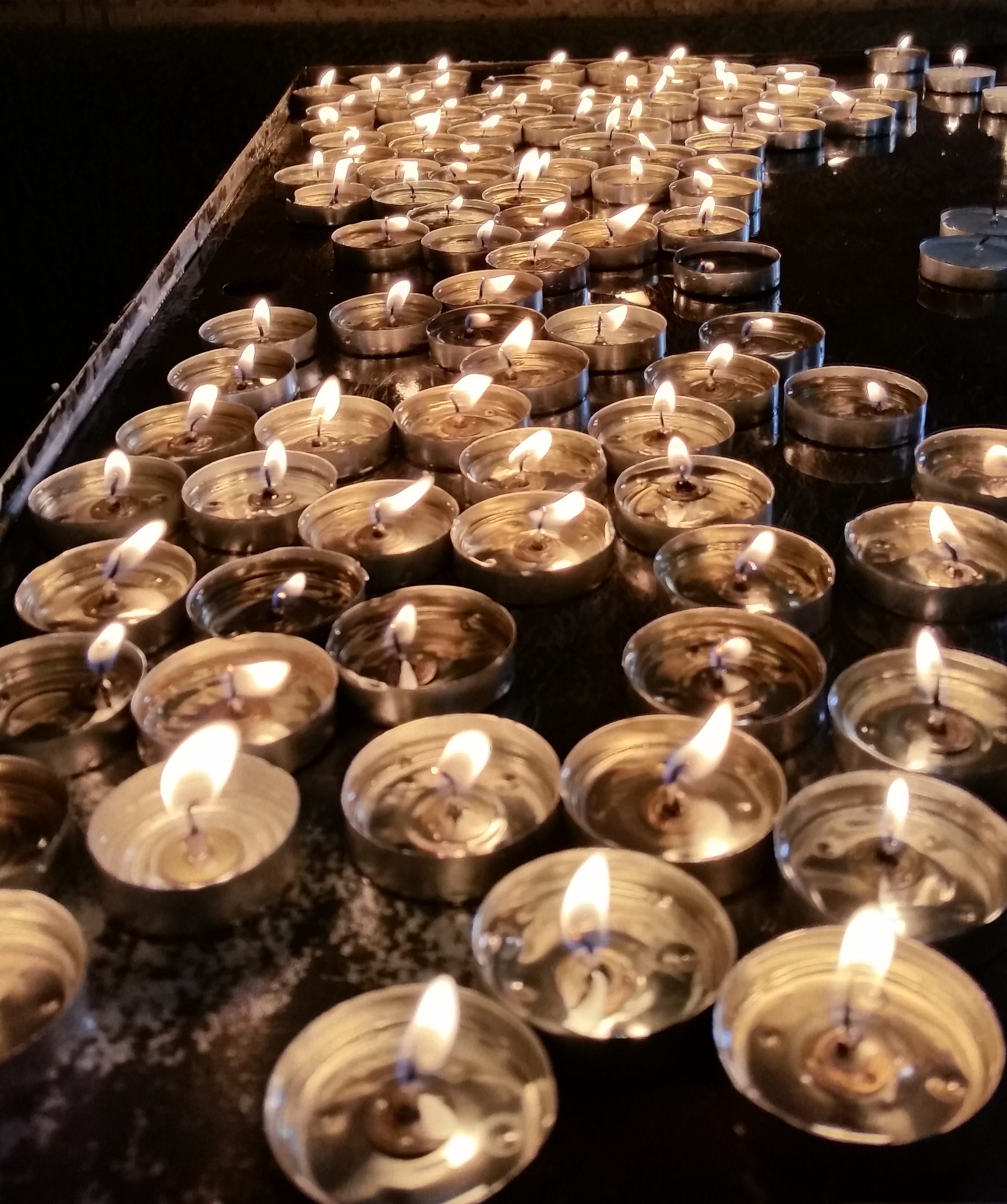
Votive candles
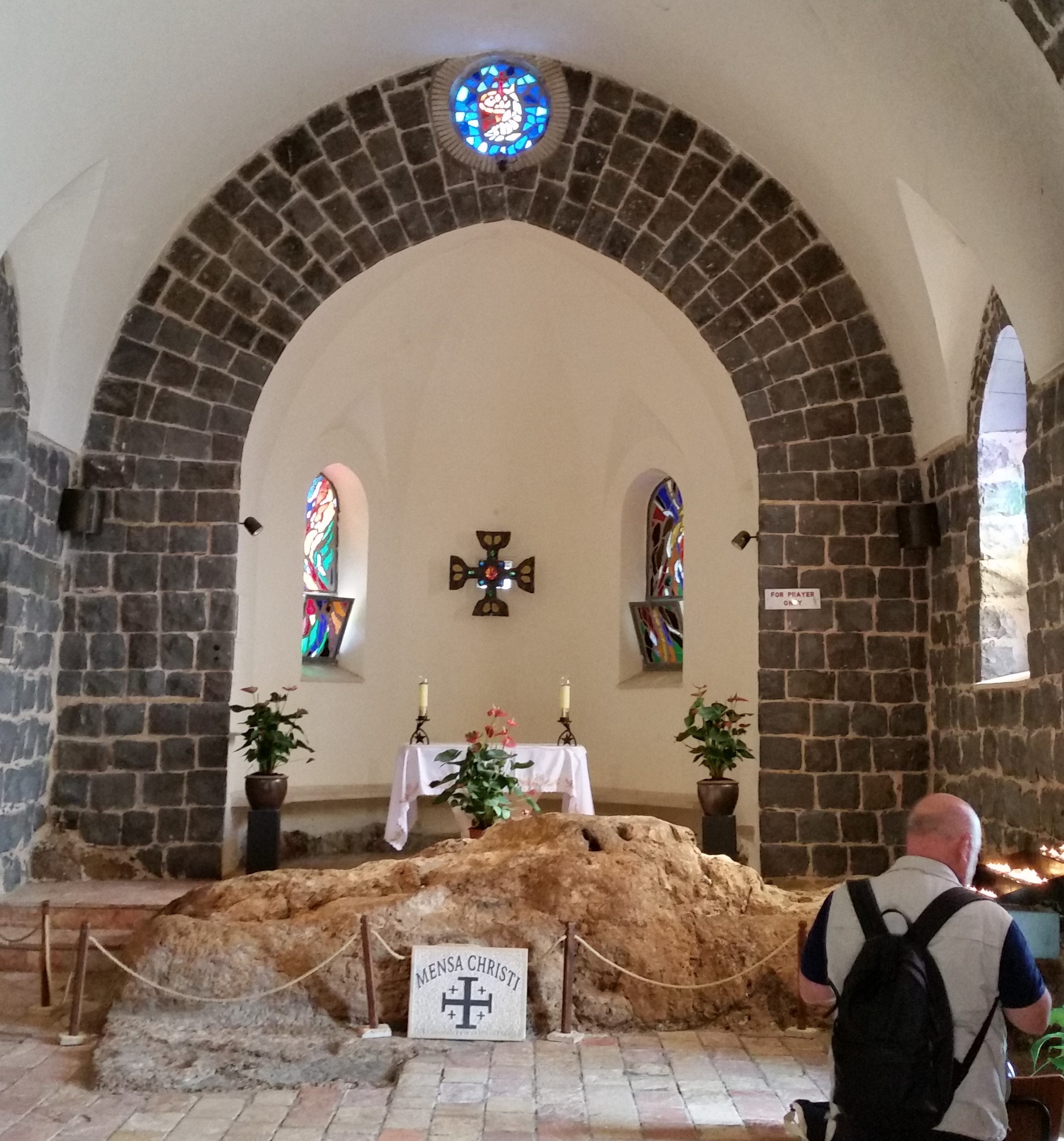
The rock symbolizing Peter’s commission
Another monument in the same area is the Church of the Primacy of St. Peter, a reminder of the occasion when Jesus gave Peter the keys of the kingdom of heaven and made him preeminent among the twelve apostles. A large rock inside the church symbolizes Peter and the priesthood authority on which Christ’s kingdom was founded.
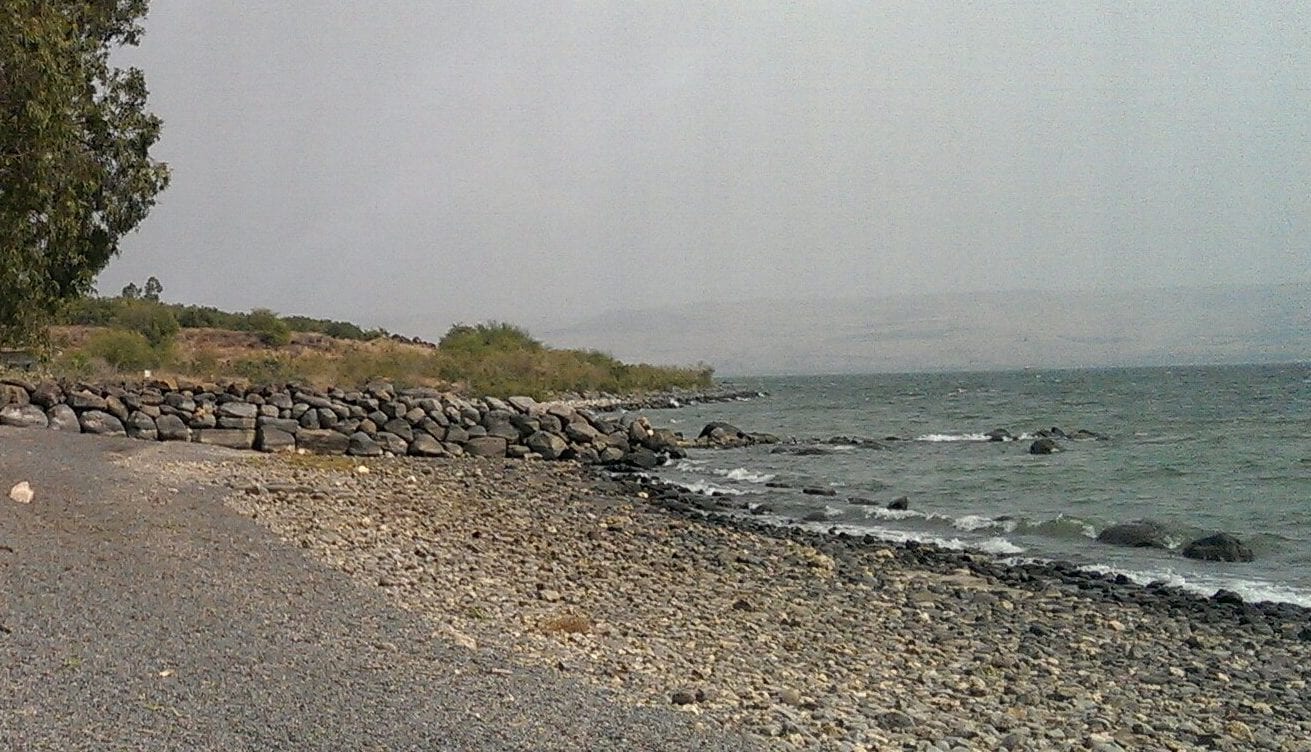
The shore near the Church of St. Peter’s Primacy
It is only a short walk from the door of the church to the shore of the Sea of Galilee. We found places to sit under the trees and on the rocks, where we could ponder the words of Christ, as well as the ideas presented in today’s devotionals. Mark T. asked us to consider Peter’s “humility and humanity,” and the tremendous progress he had made once Christ helped him recognize his own potential. Mark challenged us to find someone that we can encourage, just as Jesus encouraged Peter–as Peter later encouraged converts to the early church.
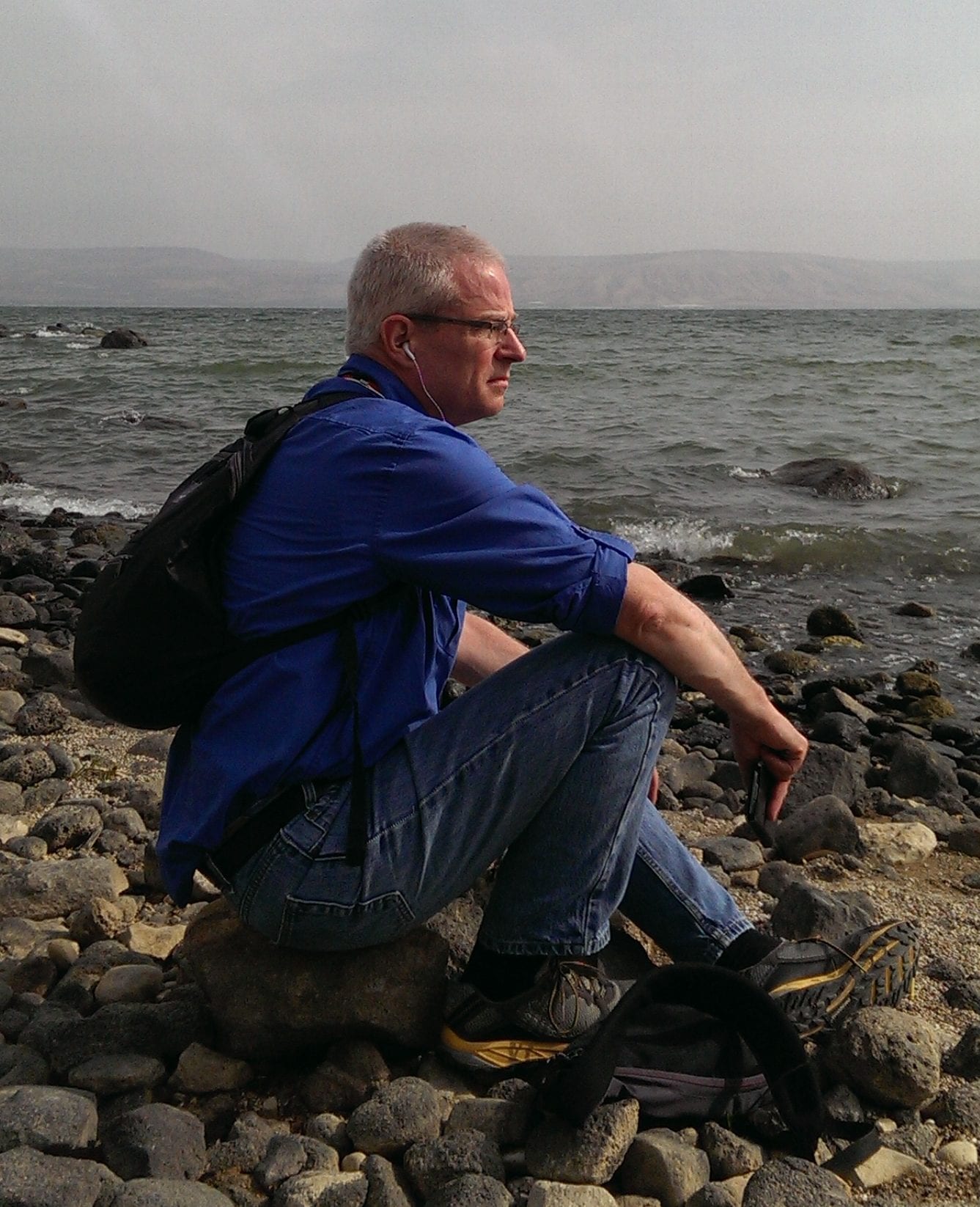
Michael ponders
Somewhere along this shore, the resurrected Jesus met the apostles who had “gone a-fishing.” Having prepared a breakfast of fried fish for them, the Lord asked, “Lovest thou me more than these [the fish]?” Then he charged them to “feed [his] sheep.” In other words, it was time for the men whom he had chosen to leave their boats and concentrate on the teaching ministry to which they had been called.
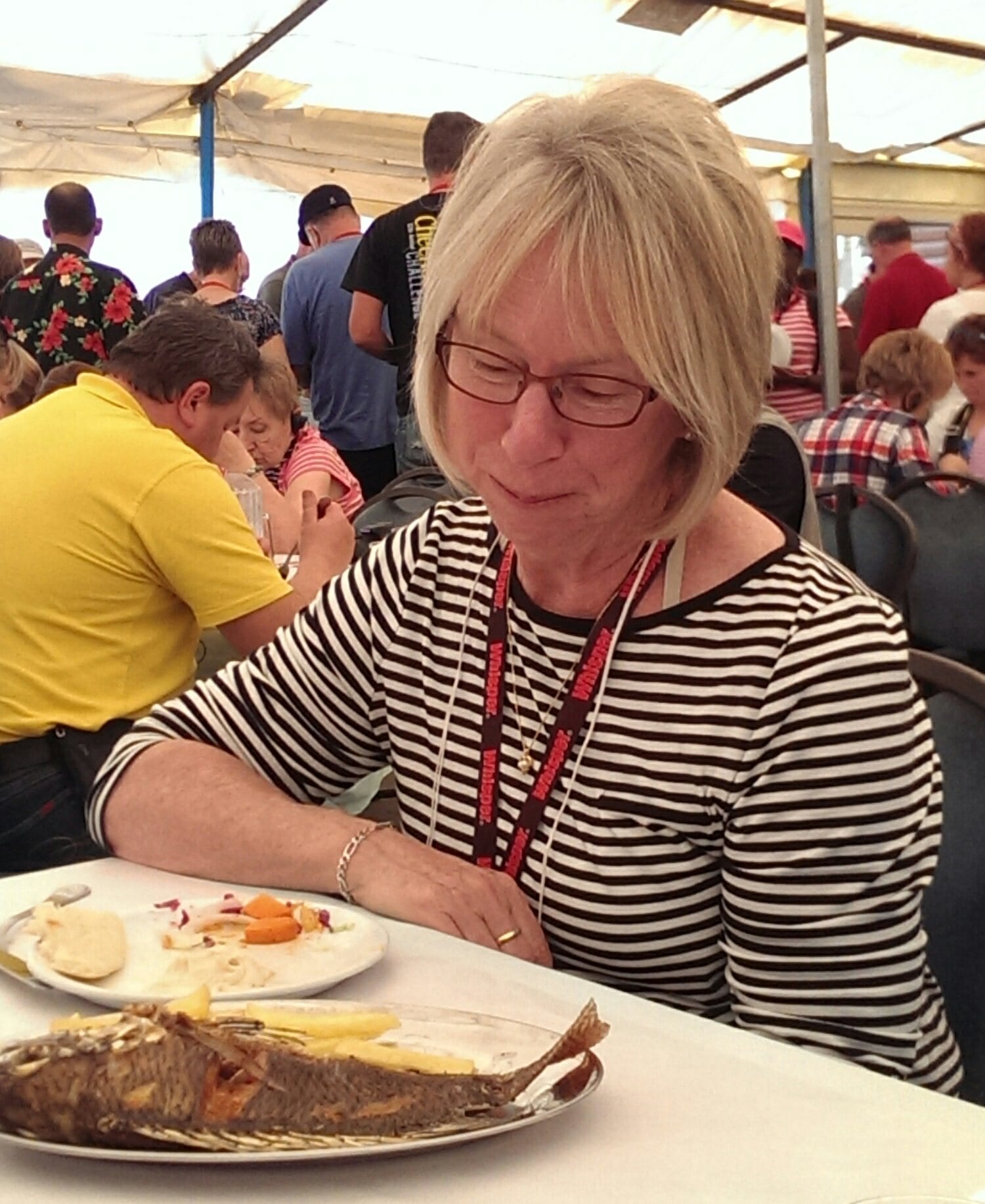
Pat wasn’t quite sure how to approach a fish with its head and tail intact
A huge refectory tent near the Church of St. Peter’s Primacy offered us the chance to share a meal of freshly fried fish from the Sea of Galilee. The fish may not have been the best seafood we’ve ever tasted, but it surely was some of the most meaningful.
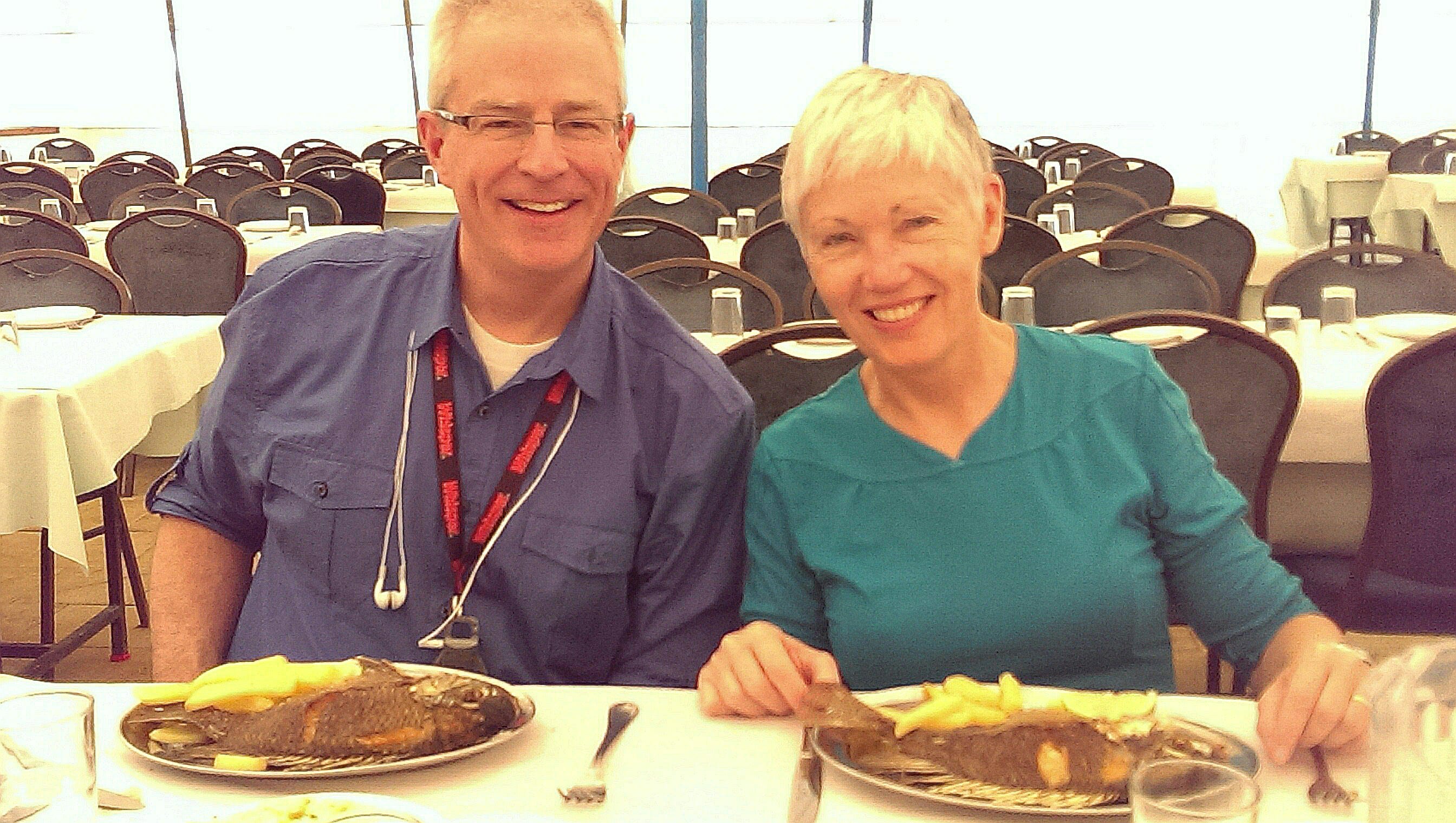
Fresh fish from the Sea of Galilee
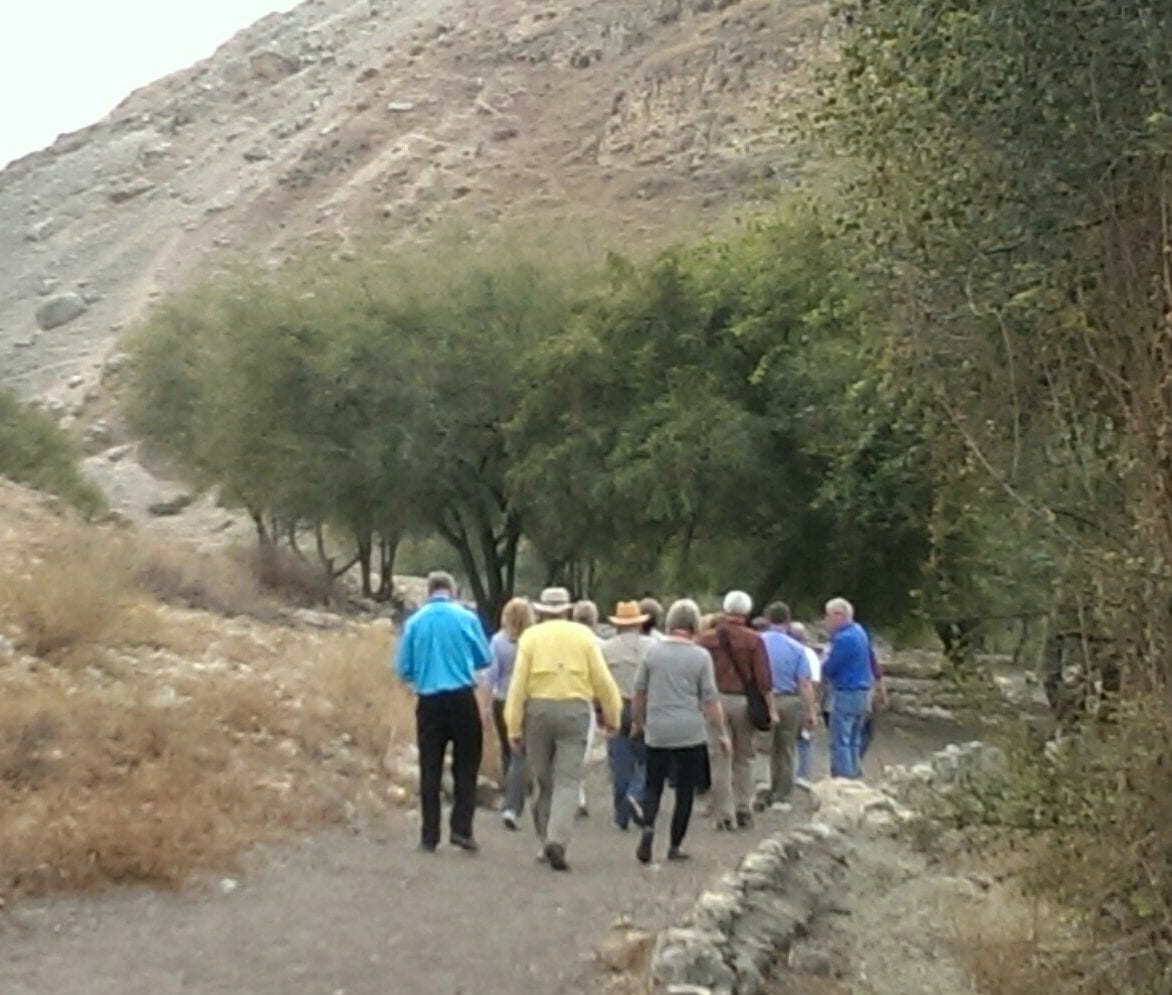
The trail through the Valley of Doves
Further down the western shore of the Sea of Galilee is the site of Magdala. Once an important fishing port and the home of Mary Magdalene, the ancient village is now in ruins (and currently under excavation, so it is not open to the public). Not far from here, during an unusually dry spell in 1986, the remains of a wooden boat dating from the first century AD was found stuck in the mud. The so-called “Jesus Boat” (the model for the King David) has been restored and is on display in a nearby museum, but we didn’t take time to see it. Instead, we got off the bus and took a walk inland along an unpaved trail through the Valley of Doves. Jesus undoubtedly traveled this route many times, because if we had followed it for several more miles, we would have reached Nazareth–but we are saving that visit for tomorrow. In the meantime, Judith retrieved a plastic bag stuck in a bush and encouraged all of us to help her fill it with the litter other wayfarers had left behind.
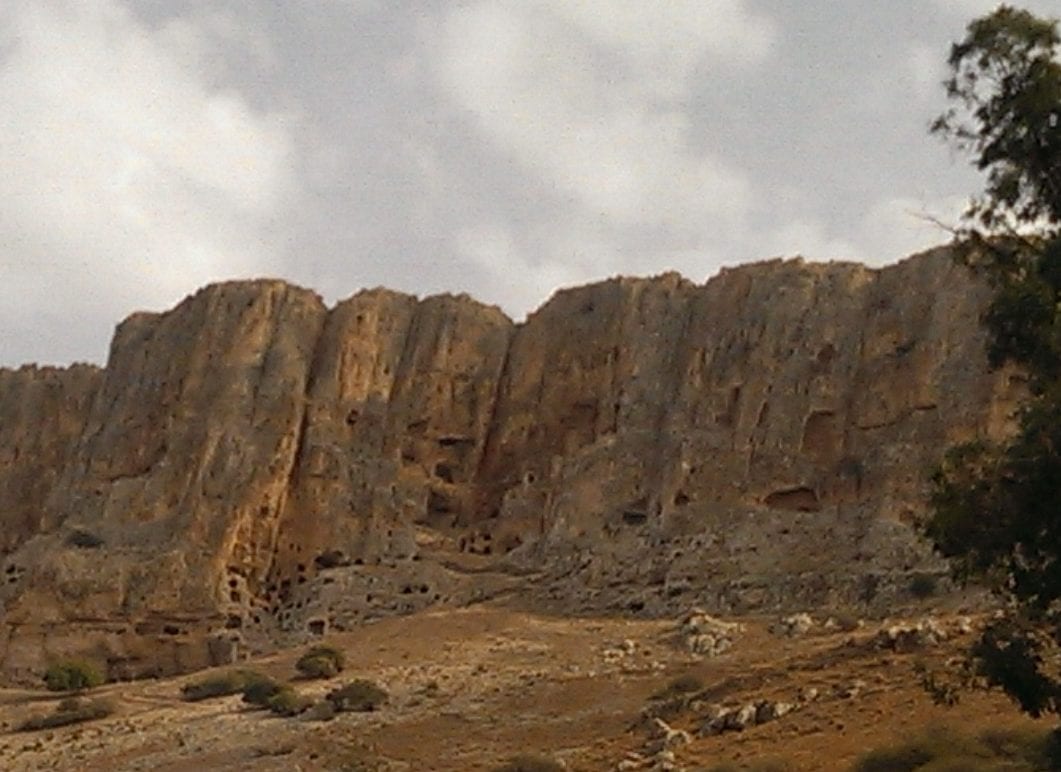
Natural caves pit the cliffs of Mount Arbel
The cliffs of Mount Arbel tower over the Valley of the Doves. Ancient Israelites hoping to escape capture by the Assyrians hid in Arbel’s many caves. Centuries later, Jewish Zealots who opposed Herod sought shelter in the same caves, but the king’s soldiers let themselves down from the summit in baskets in order to finish off the rebels.

Basilica of the Transfiguration

Detail above the main entrance into the Basilica
Not far from Mount Arbel is Mount Tabor, which offers a commanding view of the Jezreel Valley as well as the Sea of Galilee. In Old Testament times, Mount Tabor marked the territorial boundary between the tribes of Issachar, Naphtali, and Zebulun, and it was from here that the army led by Deborah and Barak marched out to defeat the local Canaanites. Since New Testament times, Mount Tabor has been identified as the tradtional site where Peter, James, and John witnessed the transfiguration of Jesus Christ. As the three apostles watched in awe, the physically glorified Savior conversed with Moses and Elias. Peter was so impressed by the experience that he suggested making three tabernacles on the mountaintop to commemorate the event, But then came something even more impressive: the group heard the voice of God declare that he was “well pleased” with his “beloved Son.” Peter, James, and John were forbidden from telling anyone of their experience until after Jesus had completed his mission and had risen from the dead.
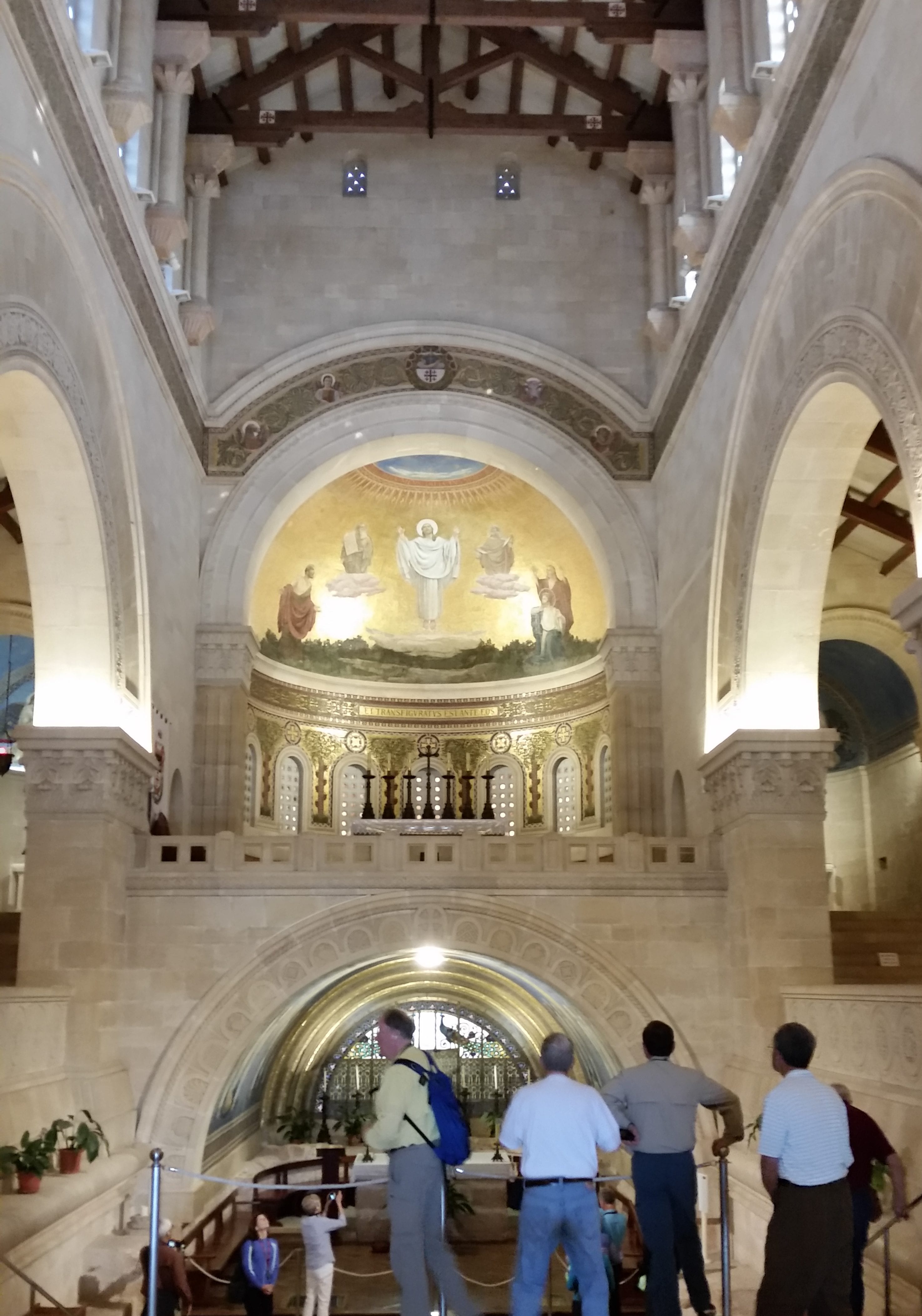
Interior of the Basilica
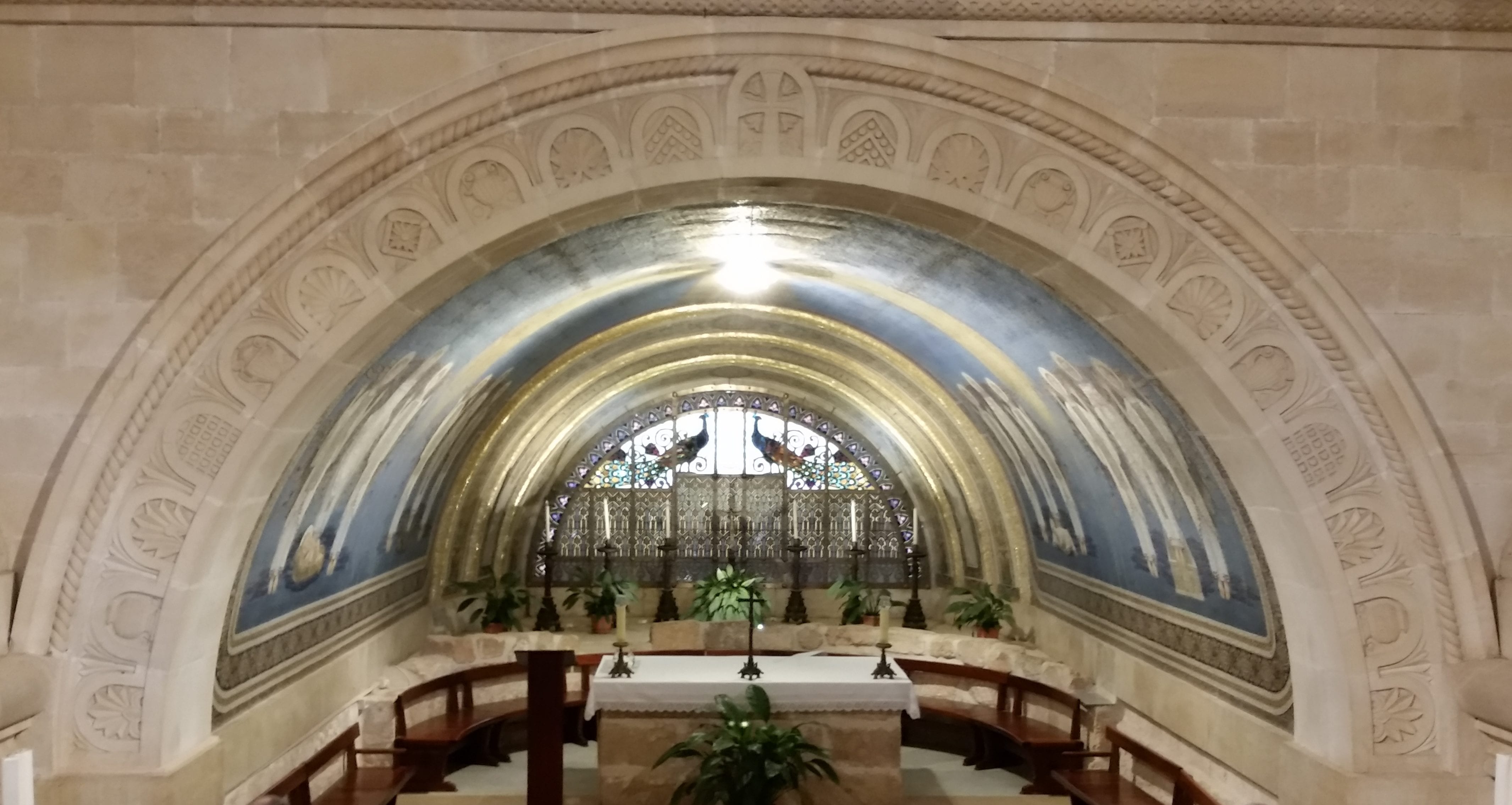
Exposed crypt of the Basilica with peacocks in the glass at the back
Whether Peter ever erected those three tabernacles, we don’t know, but of course Christians eventually built a succession of memorial churches on the site. The current incarnation is the romanesque-style Basilica of the Transfiguration, completed in 1924. It features a beautiful stained glass window depiciting a peacock. (Many of us wondered about the significance of the peacock, which we had also seen portrayed in a large mosaic in Capernaum. When we got back on our wifi-equipped bus, we were able to learn that the ancients believed–erroneously–that peacock flesh does not deteriorate like other meat, so peacocks became a symbol of immortality.)
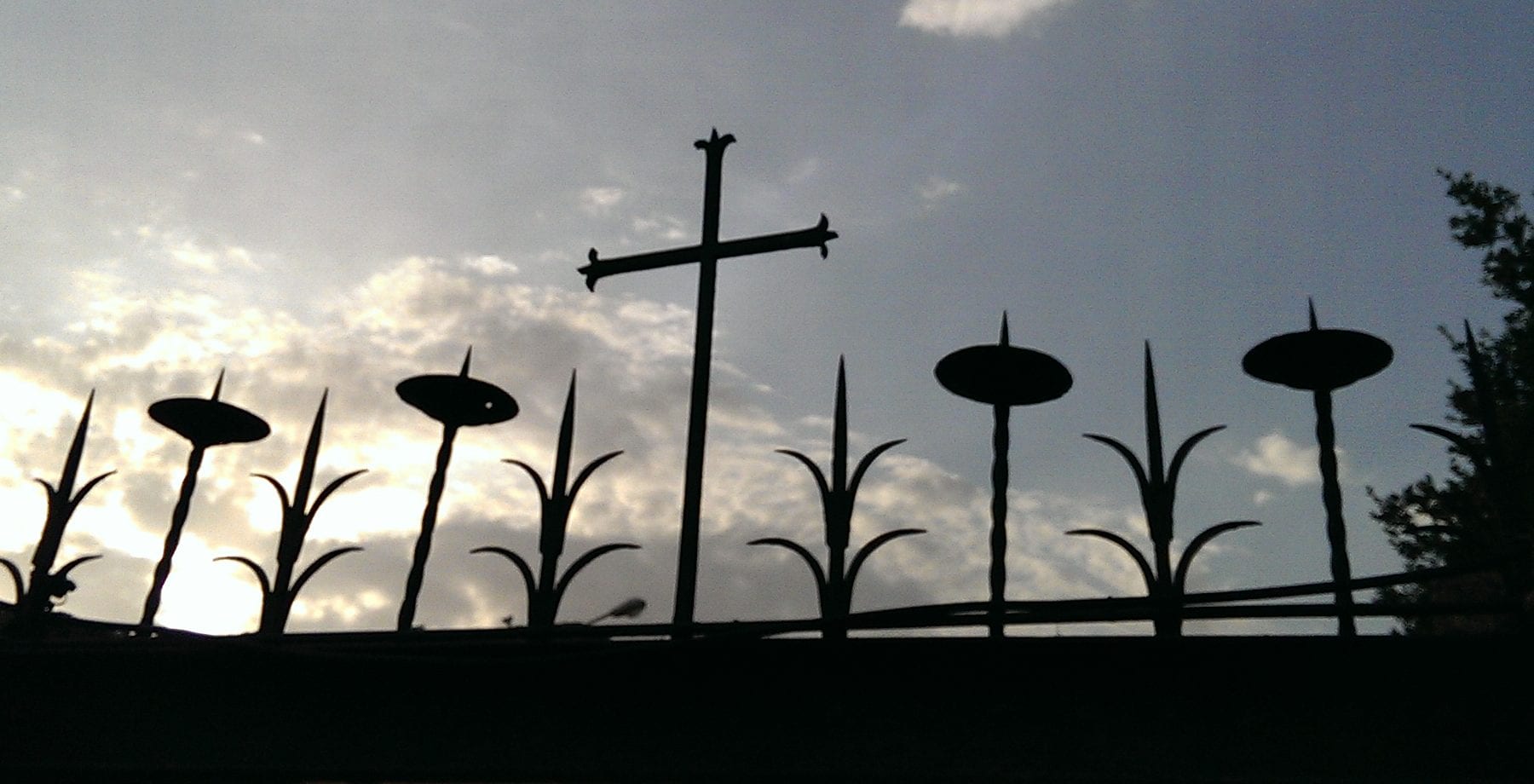
An iron cross adorns the top of the gate at the Basilica of the Transfiguration
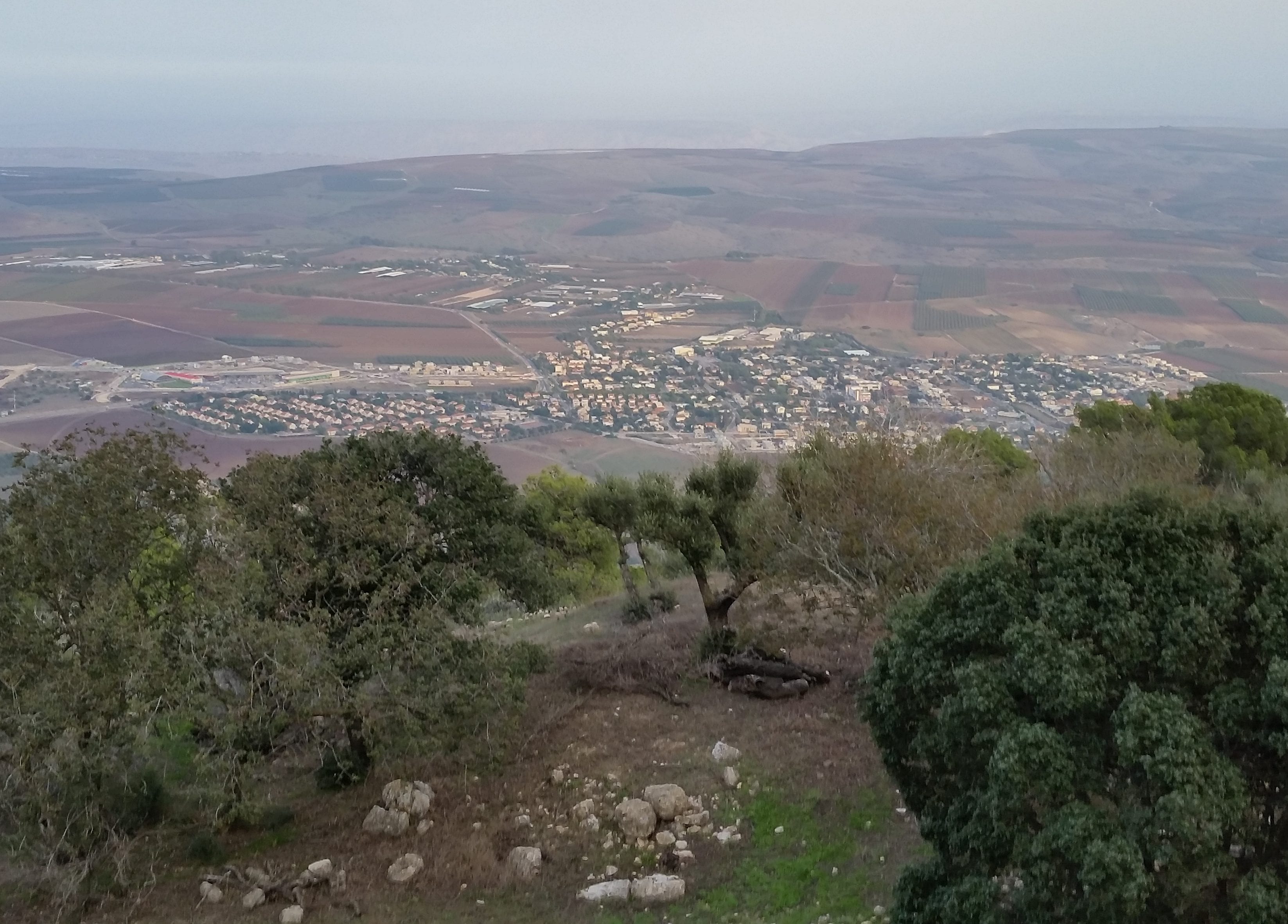
View from Mount Tabor, looking east
The sun was setting as we made our way back toward our hotel in Tiberias. On the way, we made what we hoped would be a short detour into Cana, where Jesus had miraculously turned water into wine at a wedding feast. No miracles for us this evening: traffic on the highway was backed up due to an accident and we had to be rerouted through the middle of town. (We needed no guide book to tell us that the architecture here dates from the late twentieth-century “tacky” era.) Despite our desire to avoid further rush-hour entanglements, we needed to stop at a downtown establishment whose English sign indicated that it was a “Sovner Store” so that members of our group who had already purchased more “sovners” than they could fit in their luggage could buy extra suitcases. Eddie, the bus driver, once again demonstrated uncanny command of his vehicle by executing a couple of tight U-turns and an impressive three-pointer in a crowded cul-de-sac.
Tonight we sang “Rejoice, the Lord Is King” to begin our after-dinner devotional. Jim then used John 1:45-49 as his text to prepare us for visiting Nazareth tomorrow. This passage reports Philip’s declaration to Nathanael that he had “found him, of whom Moses in the law, and the prophets, did write, Jesus of Nazareth,” and then Nathanael’s famous response: “Can there any good thing come out of Nazareth?” Like Nathanael, all of us have been invited to “Come and see.”
Leave A Comment